Text
4 Best Japanese Cleaver Knives for Your Home Kitchen
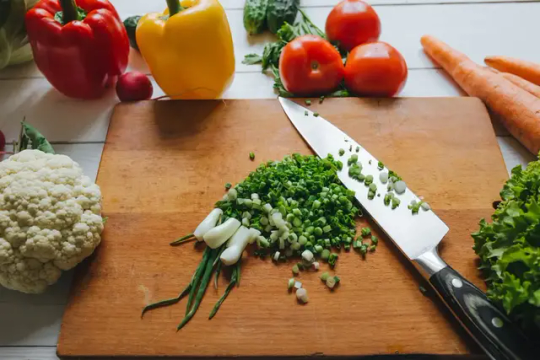
In a hurry? Look for our best pick: Global Kitchen-Knives Chop & Slice 7
Best Japanese cleaver knives are a great addition to any kitchen. They are versatile, durable, and easy to use. But with so many different knives on the market, it can be hard to know which one is the best for you. That's why we've put together a list of the 4 best Japanese cleaver knives available.
Best Japanese Cleaver Knife List
Following is the list of the 4 best Japanese cleaver knives that are available in the market in 2023:
- Global Kitchen-Knives Chop & Slice 7 inch – Top Pick
- YOUSUNLONG 7-inch Vegetable Cleaver - Best Value
- Shun Classic 7 Inch Cleaver Knife - Best Upgrade
- Imarku Cleaver Knife 7 Inch - Best Budget Pick
1. Global Kitchen-Knives Chop & Slice 7 – Our Top Pick

Global Kitchen-Knives Chop & Slice 7
If you are looking for a great all-purpose knife, the Global Kitchen-Knives Chop & Slice 7 is a great option. I'm thoroughly impressed with the Global Kitchen-Knives Chop & Slice 7! The craftsmanship is evident in the construction of the knife, from the seamless stainless steel blade to the perfectly weighted handle. It's obvious that a lot of thought went into designing this kitchen essential. The blade is rust, corrosion, and stain resistant, making it a valuable addition to my kitchen. I can't imagine cooking without it now!
Buy Now
The Global Kitchen-Knives Chop & Slice 7 is the perfect knife for chopping vegetables, slicing meat, and mincing herbs. It's also great for making precision cuts. The blade is sharp enough to make clean cuts, but not so sharp that it's dangerous. I've used this knife to chop everything from carrots to cabbage, and it has performed flawlessly every time. The Global Kitchen-Knives Chop & Slice 7 is a great investment for any home cook.
Unique Features
- The Global Kitchen-Knives Chop & Slice 7-inch Cleaver Knife is the perfect tool for chopping and slicing meats, fruits, and vegetables.
- The razor-sharp blade makes quick work of even the toughest cuts.
- The ergonomic handle provides a comfortable and secure grip.
Pros- Seamless stainless steel blade
- Rust, corrosion, and stain resistant
- Perfectly weighted handle
- Sharp enough to fulfil all your needs
- High Price Tag
- Susceptible to rust
2. YOUSUNLONG 7-inch Vegetable Cleaver - Best Value

YOUSUNLONG 7-inch Vegetable Cleaver
I was so excited when I received my Yousunlong 7-inch Vegetable Cleaver! The craftsmanship and design are superb, and the Ebony Wood handle is beautiful and feels great in my hand. This cleaver is perfect for slicing vegetables and meats, and the convex hull on the blade prevents sticking. I would highly recommend this cleaver as well to anyone looking for a quality kitchen knife.
Buy Now
The Yousunlong 7-inch Vegetable Cleaver is also one of the most perfect tools for chopping and slicing meats, fruits, and vegetables. The razor-sharp blade makes quick work of even the toughest cuts. The ergonomic handle provides a comfortable and secure grip.
Unique Features
- The Yousunlong 7-inch Vegetable Cleaver is a high-quality kitchen knife that is perfect for slicing vegetables and meats.
- The convex hull on the blade prevents sticking, making it easy to use.
- The Ebony Wood handle is beautiful and feels great in your hand.
Pros- Razor-sharp blade
- Ergonomic handle
- Convex hull on the blade prevents sticking
- Dangerous Pointed Tip near Handle
3. Shun 7-inch Cleaver Knife - Best Upgrade

Shun 7-inch Cleaver Knife
The Shun 7-inch Classic Vegetable Cleaver Knife is a great knife for cutting vegetables. The large square blade is solid yet thin and nimble, making it easy to use. It is also constructed with Shun's proprietary VG-MAX cutting core and clad in 68 layers of stainless Damascus, making it corrosion and stain resistant with a strong, razor-sharp edge. The ebony-finished D-shaped handle provides a comfortable grip.
Buy Now
The Shun 7-inch Classic Vegetable Cleaver Knife is a great investment for any home cook. Although it's an expensive but really great addition to your kitchen.
Unique Features
- It has a solid, thick, and nimble square blade.
- Made with VG-MAX cutting core and clad in 68 layers of stainless steel.
- The traditional Artisan look that's often found in Japanese and Chinese knives.
Pros- The large square blade is perfect for cutting vegetables
- Constructed with Shun's proprietary VG-MAX cutting core and clad in 68 layers of stainless Damascus
- Ebony-finished D-shaped handle provides a comfortable grip
- Expensive One
- Need little sharpening before first use
4. Imarku Cleaver Knife 7 Inch - Best Budget Pick

Imarku Cleaver Knife 7 Inch
As a low-budget person, I found the Imarku Cleaver Knife 7 Inch German High-Carbon Stainless Steel Chopper Knife to be an excellent value. The knife is made of 5cr15mov high-carbon German steel, making it both sharp and durable.
Buy Now
The Pakkawood handle is specially treated to seal the pores of the wood, making it moisture-resistant. The handle also has a comfortable grip and is easy to clean. Overall, I highly recommend this meat cleaver knife to anyone looking for an affordable option.
Unique Features
- High-carbon German steel construction gives it increased strength and hardness.
- Additionally, the knife's Pakkawood handle has been treated to seal the pores of the wood, providing a comfortable and moisture-resistant grip.
Pros- German high-carbon steel construction
- Moisture-resistant Handle
- Easy to clean and Low Price
- A bit lower quality than the above knives
- Lower Height of Blade
What is The Top Pick of All Items?
The Global Kitchen Knives Chop & Slice 7-inch is the top pick for the best Japanese Cleaver Knife. It is a great all-purpose knife that is perfect for chopping vegetables, slicing meat, and mincing herbs. The blade is razor-sharp and makes quick work of even the toughest cuts. The ergonomic handle provides a comfortable and secure grip.
Which Cleaver is The Best Upgrade for Your Kitchen?
The Shun 7-inch Classic Vegetable Cleaver Knife is the best upgrade to your kitchen. It has a solid, thick, and nimble square blade that is perfect for cutting vegetables. Additionally, the knife is constructed with Shun's proprietary VG-MAX cutting core and clad in 68 layers of stainless Damascus.
Things to Consider while Buying Best Japanese Meat and Vegetable Cleaver Knives
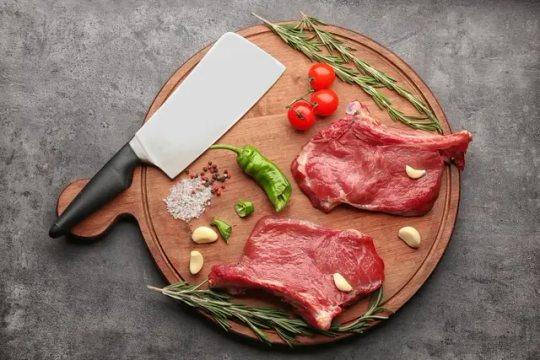
Cleaver knife with Japanese style design, perfect for Asiancuisine lovers
Now that we have looked at four of the best Japanese Cleaver knives, it's time to look at some things you should consider before making your purchase.
1. The Type of Blade
When choosing a cleaver knife, one of the most important things to consider is the type of blade. The two most common types of blades are the Western-style and the Santoku.
The Western-style blade is typically longer and heavier, making it great for chopping through thick cuts of meat. The Santoku blade, on the other hand, is shorter and lighter, making it better suited for slicing vegetables.
2. The Size of the Blade
Another important consideration is the size of the blade. Cleaver knives come in a variety of sizes, from small to large.
The size of the blade you choose will depend on what you plan to use it for. If you only plan on using it for occasional slicing and dicing, then a smaller blade will suffice. However, if you plan on using it for more heavy-duty tasks, such as chopping through bone, then you'll need a larger blade.
3. The Material of the Blade
The material of the blade is also an important consideration. Cleaver knives are typically made from either stainless steel or carbon steel.
Stainless steel blades are less likely to rust and are easier to care for, but they are not as sharp as carbon steel blades. Carbon steel blades, on the other hand, are extremely sharp but require more maintenance to prevent rusting.
4. The Handle
The handle is another important consideration. Cleaver knives come with a variety of different handle materials, from wood to plastic.
Wooden handles are the most traditional, but they require more care to prevent them from drying out and cracking. Plastic handles are more durable and easier to care for, but they can be less comfortable to hold.
5. The Price
Of course, one of the most important considerations is the price. Cleaver knives range in price from around $30 to $200.
The price you pay will depend on the quality of the knife and the features you want. If you only need a basic cleaver knife for occasional use, then you can get by with a less expensive model. However, if you plan on using it frequently or for more heavy-duty tasks, then you'll need to invest in a higher-quality knife.
Conclusion:
After carefully considering all the features of each knife, we believe that the Global Kitchen Knives Chop & Slice 7-inch are the best Japanese Cleaver Knives. The razor-sharp blade and convex hull make it easy to use, while the ergonomic handle provides a comfortable grip. If you are looking for an upgrade to your kitchen, we recommend the Shun 7-inch Classic Vegetable Cleaver Knife. It is a great investment for any home cook.
Hope this article helped you in choosing the best cleaver knife as per your requirement. Do comment below if you have any queries related to this article. Stay sharp!
Read the full article
0 notes
Text
What is a Nakiri Knife Used For? The Kitchen Essential You Didn't Know You Needed

A Nakiri knife is a type of Japanese vegetable knife that is characterized by its rectangular blade and straight blade edge. It is commonly used in Japanese cuisine for the preparation of vegetables, meat, and fish. The word “Nakiri” actually means “leaf knife” in Japanese.
If you're looking for a versatile and durable kitchen knife that will make light work of all your chopping needs, then a Nakiri knife is the perfect option for you. In this blog post, we'll take a closer look at what a Nakiri knife is, what is a nakiri knife used for, and some of the best Nakiri knives on the market today.
What Is Nakiri Knife?
The Nakiri knife is a Western-style vegetable knife with square-shaped and wide blades with curved cutting surfaces. It was specifically designed for rapid and efficient cutting, dicing, and mincing of vegetables and fruits and has become an essential food for vegetarians and home cooks in Japan. Nakiri knives are often called the double bevel versions of Usuba, which is a special Japanese single bevel knife recommended for culinary professionals.
What is a Nakiri Knife Used For?

Nakiri knives are Japanese-style knives used primarily for chopping, mincing, and slicing vegetables.
As we mentioned above, Nakiri knives are most commonly used for slicing, dicing, and chopping vegetables. They can also be used for mincing meats and fish, but what's best suited for is vegetables. The straight blade edge of the Nakiri knife makes it ideal for precise cuts, which is why it's such a popular choice amongst professional chefs.
If you're someone who enjoys cooking at home and wants to up your chopping game, then investing in a Nakiri knife is definitely worth considering. Not only will it make light work of all your chopping needs, but it will also last you for many years to come if properly cared for.
Some Features of Nakiri Knife
Now, we'll take a closer look at the features of Nakiri knives so that you can better understand what makes them so special.
Blade Design
One of the most distinguishing features of Nakiri knives is their rectangular blade design. This design is well-suited for cutting vegetables because it provides a large cutting surface area and allows for precision chopping. The blades of Nakiri knives are also relatively thin, which makes them ideal for slicing vegetables thinly and evenly.
Shape
Another notable feature of Nakiri knives is their shape. Unlike chef’s knives, which have a curved blade, Nakiri knives have a straight blade edge. This straight blade edge allows for precision chopping and makes it easy to follow the contours of the cutting board. Additionally, the straight blade edge prevents food from sticking to the knife while cutting.
Edge Grind
The edge grind of a Nakiri knife is another important feature to consider. The edge grind refers to the angle at which the blade has been sharpened. For Nakiri knives, the ideal edge grind is between 15 and 20 degrees. This relatively low-edge grind results in a sharper blade that can retain its edge for a longer period. However, it should be noted that blades with a lower-edge grind are more likely to chip or become damaged if not used properly.
As you can see, there are many features that make Nakiri knives so special. Just be sure to take care of your Nakiri knife and use it properly to avoid any damage to the blade.
The Differences Between Nakiri and Santoku Knives
Nakiri and Santoku knives are two of the most popular kitchen knives on the market today. Though they may look similar at first glance, there are quite a few differences between these two types of blades. Here, we'll be exploring the key differences between Nakiri and Santoku knives so that you can make a good decision about which type of knife is right for your needs.
Nakiri knives
Nakiri knives are Japanese-style vegetable knives that are characterized by their long, rectangular blades. The blades of Nakiri knives are typically sharpened on both sides, which makes them ideal for slicing vegetables into thin, even pieces. Because of their shape, Nakiri knives are also well-suited for chopping vegetables into larger pieces.
Santoku knives
Santoku knives, on the other hand, are Japanese-style all-purpose knives that can be used for a variety of tasks in the kitchen. Santoku knives have shorter, curved blades that are sharpened on one side only. The curved shape of Santoku blades makes them ideal for slicing and dicing meat and fish.
Both Nakiri and Santoku knives offer distinct advantages for different tasks in the kitchen. If you're looking for a versatile knife that can handle a wide range of tasks, then a Santoku knife is probably the best option for you. If you're looking for a knife that excels at chopping vegetables, then a Nakiri knife is likely the better choice. Ultimately, the type of knife you choose should be based on your own specific needs and preferences.
The Difference Between Nakiri and Usuba Knives
When it comes to Japanese vegetable kitchen knives, there are two that are most commonly used: the nakiri and the usuba. Both are vegetable knives that are essential for any sushi chef. So, what's the difference between the two? Let's take a closer look.
Nakiri
The nakiri is a rectangular knife that is great for chopping vegetables. It has a sharp edge that is good for precise cuts.
Usuba
The usuba, on the other hand, is a round knife that is better for slicing vegetables. The usuba also has a thinner blade, which makes it easier to create paper-thin slices.
Nakiri vs Usuba: Which One Should You Use?
The answer to this question depends on what you will be using the knife for. If you need to chop a lot of vegetables, then the nakiri is the better choice. However, if you need to slice vegetables thinly, then the usuba is the better option.
Points to Consider When Buying a Nakiri Knife

A blade's material is the first and most important consideration
As mentioned before, Nakiri is a Japanese-style knife that is characterized by its sharpness and straight blade. The nakiri knife is also lightweight, making it easy to control. Below are a few points to keep in mind when you are looking to purchase a nakiri knife.
- Size
First and foremost, you need to consider the size of the knife. Nakiri knives come in different sizes, so it is important to choose one that is comfortable for you to hold and use. If you are going to be doing a lot of chopping, then you might want to opt for a larger knife. If you only plan on using it for smaller tasks such as slicing vegetables, then a smaller knife should suffice.
- Blade Material
Another thing to keep in mind is the blade material. Nakiri knives typically have either carbon steel or stainless steel blades. Carbon steel blades are sharper but they are also more susceptible to rusting. Stainless steel blades, on the other hand, are not as sharp but they are easier to maintain and less likely to rust.
- Handle
You should also think about the knife's handle. It should be comfortable to hold, strong and durable, and water resistant so that it does not become slippery when wet.
- The Blade Finish
When it comes to kitchen knives, the blade finish is also an important factor to consider.
There are three main types of blade finishes: polished, hammered, and brushed.
Each one has its unique benefits and drawbacks.
Polished blades are the most common type of finish and they are the sharpest. However, they also require the most maintenance because they can easily get scratched.
Hammered blades are less sharp than polished blades but they are more resistant to scratches. They also have a unique look that some people prefer.
Brushed blades are not as sharp as either polished or hammered blades, but they are the most durable and least likely to rust.
With these considerations in mind, you should be able to find the perfect nakiri knife for your needs!
Is a Nakiri knife good for meat?
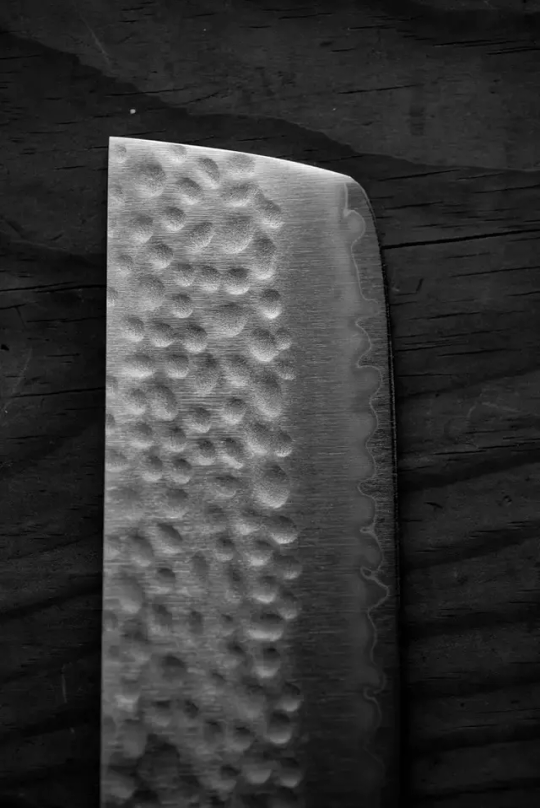
It is also useful for cutting up fish portions, chopping up chicken, and cubing meat
While Nakiri knives are not specifically designed for cutting raw meat, they can be used for this purpose. They have a rectangular sharp blade that can make quick work of meat, although it is not as efficient as a butcher's knife.
Conclusion
A Nakiri knife is an essential piece of kitchen equipment that every home cook should own. If you're looking for a versatile and durable kitchen knife that will make light work of all your chopping needs, then a Nakiri knife is the perfect option for you.
In this blog post, we took a closer look at what's a Nakiri knife, what is a Nakiri knife used for, and points to consider while buying nakiri knives. Investing in a quality Nakiri knife is definitely worth considering if you want to take your home cooking to the next level.
FAQs
Is a nakiri knife worth it?Yes, a nakiri knife is definitely worth the investment. It is a versatile and durable kitchen knife that will make light work for all your chopping needs.What is a nakiri knife used for?Nakiri knives are typically used for chopping vegetables.What does Nakiri mean in Japanese?Nakiri is a Japanese word that means "veggie or leaf knife." It is named after its rectangular shape which is perfect for chopping vegetables.
Read the full article
0 notes
Text
A Comprehensive Guide to 11 Types of Japanese Knives and Their Uses

In the world of kitchen knives, Japanese blades are some of the sharpest, most durable, and most popular on the market. Whether you're a professional chef or a home cook who loves to be in the kitchen, having a good quality knife is important.
But with so many different types of Japanese knives available, it can be hard to know which one is right for you. That's why we've put together this comprehensive guide to the types of Japanese cooking knives and their uses.
Different Types of Japanese Knives
So, below is the list of 11 Japanese kitchen knife types. Each type has its own features and speciality. They all serve different purposes except for some knives such as Kiritsuke and Santoku knives which are considered multi-purpose. So, whether you’re looking to learn about Japanese chef knife types or fish knife types, we’ve got you covered.
- Gyuto Knife | Chef's Knife
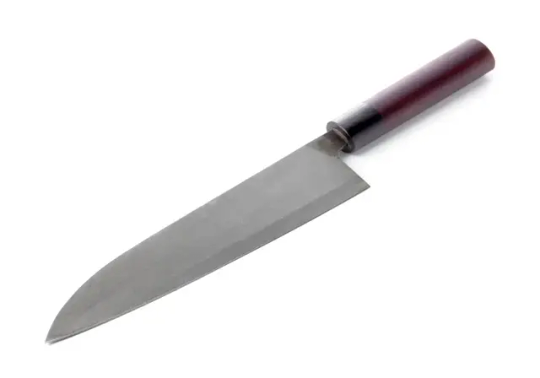
A versatile chef's knife, the gyutou can be used to prepare Western cuisine as well
The gyuto knife is a Japanese chef's knife that can be used for a variety of tasks, including mincing, slicing, and dicing. It typically has a curved blade that is between 18 and 30 cm long. This type of knife is very versatile and can be used for both Western and Japanese cuisine.
- Santoku Knife | Multi-Purpose Knife

Santoku is suitable for mincing, slicing, and dicing
The Santoku knife is another type of versatile chef's knife that can be used for a variety of tasks, including mincing, slicing, and dicing. It typically has a shorter blade than the gyuto knife, between 14 and 20 cm long. Santoku knives are often used in Japanese cuisine because of their versatility.
- Nakiri Knife | Vegetable Knife

Vegetarians love this knife for quick and efficient cutting, dicing, and mincing of vegetables.
The Nakiri knife is a type of vegetable knife that is typically used for chopping vegetables. It has a straight blade that is between 13 and 18 cm long. This type of knife is very thin and lightweight, making it easy to manoeuvre.
- Usuba Knife | Vegetable Knife
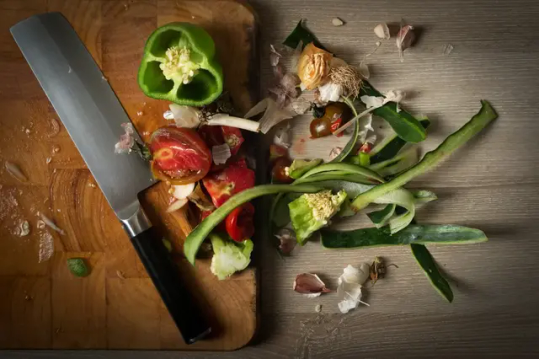
The usuba knife is a traditional single-bevel knife used by Japanese chefs for preparing vegetables
The usuba knife is another type of vegetable knife that is typically used for chopping vegetables. It has a straight blade that is between 15 and 20 cm long. This type of knife is slightly thicker than the nakiri knife but still relatively thin compared to other types of knives.
- Petty | Utility Knife
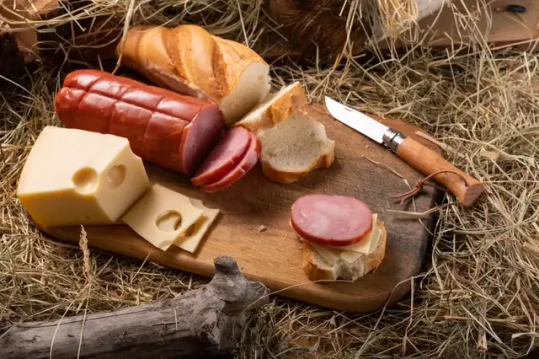
It's for peeling fruits and vegetables by hand, but it can also be used to do small tasks on a cutting board
A utility knife is a versatile tool that can be used for a variety of tasks, from opening boxes to cutting rope. Petty knives are a type of utility knife that is smaller in size, making them ideal for more delicate jobs. Petty knives typically have a blade length of 4-6 inches, and they often come with a serrated edge that can be used for sawing. In addition, most petty knives have a liner lock that helps to keep the blade securely in place.
- Deba | Butcher's Knife

A debas is a thick, stout knife used to fillet fish traditionally in Japan
A deba is a Japanese-style knife that is commonly used for butchering fish. It has a thick blade that tapers to a sharp point, making it ideal for cutting through bones. The deba is also well-suited for chopping vegetables and can be used to fillet fish. While it is similar in many ways to a Western-style chef's knife, the deba is typically smaller and lighter, making it easier to handle.
In addition, the deba's blade is usually positioned at a slightly different angle, which makes it better suited for slicing fish. As a result, the deba is an essential tool for any chef who specializes in Japanese cuisine.
- Yanagi | Sushi Knife

A long, thin knife like this is an essential tool for sushi chefs in Japan
A Yanagi is a traditional Japanese sushi knife. It is long and thin, with a single-edged blade. The blade is usually made from carbon steel, which gives it a sharpness that is ideal for slicing fish.
Yanagi knives are an essential tool for sushi chefs, as they allow for precision cuts that retain the delicate flavour and texture of the fish. In addition to sushi, Yanagi knives can also be used for slicing other foods such as meats and vegetables.
- Honesuki | Boning Knife

Designed specifically for deboning and breaking down poultry, the Honesuki can be used to cut anything into pieces
A honesuki is a traditional Japanese kitchen knife that is used for boning and filleting. It is characterized by its sharply pointed tip and relatively short blade, which makes it ideal for manoeuvring around bones. The honesuki is typically made from carbon steel or stainless steel, and it is usually between 150 and 170mm in length.
While it is possible to use a honesuki for tasks such as slicing vegetables or cutting meat, it is generally considered to be a specialist knife that is best suited for boning work.
- Kiritsuke | Multi-Purpose Knife
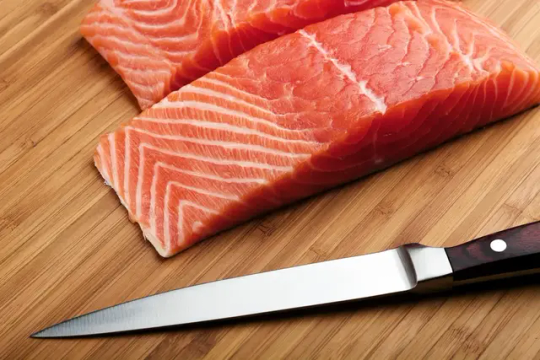
A Kiritsuke is a great tool for cutting vegetables and slicing fish. But it cannot replace a chef's knife
The Kiritsuke is a multi-purpose knife that is commonly used in Japanese cuisine. It is characterized by its long, straight blade, which can be used for slicing, dicing, and chopping. The name Kiritsuke comes from the Japanese word for "carving," which refers to the knife's primary function. The Kiritsuke is also commonly used to fillet fish, as the blade is thin and sharp enough to easily remove the skin. In addition, the Kiritsuke can be used to create decorative cuts known as sushi rolls.
- Pankiri | Serrated Knife
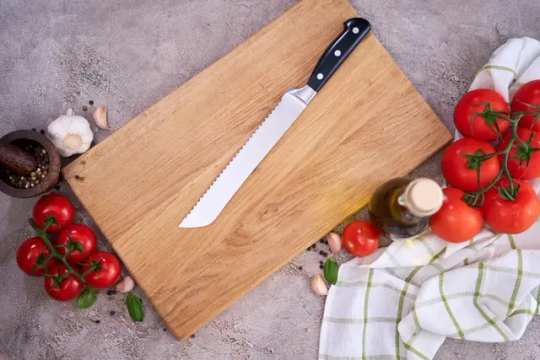
Pankiri knives have long, serrated blades that are characterized by their use for bread, also suitable for soft fruit and vegetables
The pankiri is a serrated knife from Nepal that has a long, curved blade. The blade is made of high-carbon steel and is designed for both chopping and slicing. The pankiri is used in Nepalese cooking for everything from cutting vegetables to carving meat. The knife is also popular in the Himalayan region for use in hunting and camping. The Pankiri has a distinctive appearance, with its curved blade and long handle. The knife is also unique in that it can be used for both chopping and slicing.
- Takobiki | Slicing Knife
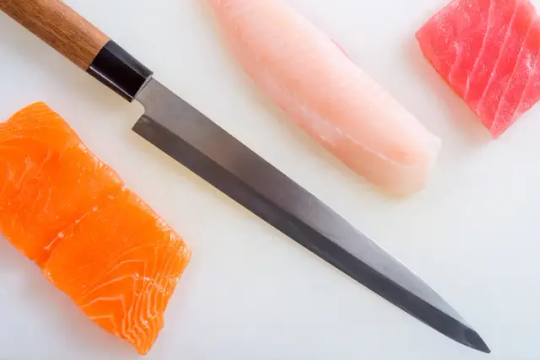
You can easily slice fish for sushi and sashimi with Takobiki knife
Takobiki is a type of Japanese slicing knife that is traditionally used for preparing sashimi. The blade is long and thin, with a sharp edge that curves slightly towards the tip. This design allows the knife to slice through fish with ease, while also producing beautiful, paper-thin slices. Takobiki knives are usually made from high-quality carbon steel or stainless steel.
Conclusion
No matter what type of cooking you do, having a good quality knife is important. And when it comes to quality kitchen knives, Japanese blades are some of the best on the market. With so many different types available, though, it can be hard to know which one is right for you. Hopefully, this guide has given you a better understanding of the different types of Japanese knives and their uses so that you can make an informed decision about which one is right for you!
Read the full article
0 notes
Text
Pakkawood Knives-Few Facts

Pakkawood knives: You might have seen the word “pakkawood” in the past, but you probably didn’t know what it was. Well, now you do! In this post, you’ll learn about the fascinating history of pakkawood and how it has been used to make some of the best-selling kitchen knives in the world.
For centuries, pakkawood has been used to make knives and other tools. It’s made up of a tree called the Pakkawood tree which grows in India. It is also called Indian rosewood is very hard and has a reddish-brown color. The first pakkawood knives were made around the beginning of the 20th century. These early knives were mostly imported and sold at a very high price. Today, it is a very popular material for making kitchen knives.
Pakkawood knives Composition & Appearance

There are a few different types of pakkawood, depending on the type of wood and the method of production. In general, pakkawood is composed of about 70% carbon, 26% hydrogen, and 3% oxygen.
You will see that the composition of pakkawood is similar to that of hardwoods such as maple, cherry, and hickory. It is also identical to softwoods such as boxwood and ebony. The appearance of pakkawood is also very much like that of hardwoods.
In today’s world, pakkawood has become one of the most important materials used to make kitchen knives. The material is used because it is so hard. It is also solid and very resistant to heat and moisture. A typical kitchen knife made of pakkawood weighs almost three pounds. You can find pakkawood knives in all shapes and sizes. Many of them come with wooden handles. However, many people prefer to buy pakkawood knives with stainless steel handles. Pakkawood is also available in different colors. Some pakkawood knives come in black or a dark brown color while others have a red, orange, or yellow color.
Pakkawood uses
Pakkawood is well-known for its use in kitchen knife handles. Both Western and Japanese-style knives can now be found with pakkawood handles. The smooth, colorful appearance of pakkawood sets it apart from traditional wooden handles.
Advantages of a pakkawood handle
- Durability: Pakkawood is a strong and durable material that can withstand frequent use and maintain its shape and color over time.
- Comfort: The smooth surface and contoured design of a pakkawood handle provide a comfortable grip for the user.
- Aesthetics: The vibrant colors and patterns of pakkawood add a stylish and unique look to kitchen knives.
- Hygiene: Pakkawood is non-porous, which means it is resistant to bacteria, making it a hygienic choice for knife handles.
- Water resistance: Pakkawood is resistant to water, making it an ideal choice for kitchen knives that are frequently washed.
- Versatility: Pakkawood handles can be found in a variety of styles and designs, making it a versatile option for different types of kitchen knives.
Disadvantages of a pakkawood handle
- Cost: Pakkawood is a relatively expensive material, which can make knives with pakkawood handles more costly than those with other types of handles.
- Moisture sensitivity: While pakkawood is water resistant, it can still be affected by prolonged exposure to moisture, which can cause warping or cracking.
- Maintenance: Regular oiling or waxing is required to maintain the appearance and integrity of pakkawood handles.
- Color fading: Over time, the color of pakkawood handles may fade due to exposure to sunlight or other factors.
- Not heat-resistant: Pakkawood handles can become hot or burn when placed near a heat source, making them less suitable for specific kitchen tasks.
- Limited availability: Pakkawood is not a widely available material, making it harder to find knives with pakkawood handles.
FAQ
What is Pakkawood?Pakkawood is a type of composite material made by bonding layers of wood veneer and resin under high heat and pressure. It's often used in making kitchen knives, cutting boards, and other kitchen utensils, known for its durability and resistance to warping.What is a Pakkawood knife and how is it made?A Pakkawood knife is a knife with a handle made from a combination of resin-impregnated hardwood and high-pressure pressing. It's made by bonding layers of hardwood veneers with resin under high pressure and heat to create a durable and attractive handle material.How do you care for pakkawood?To care for pakkawood, it is recommended to hand wash with mild soap and water, dry immediately, and avoid prolonged exposure to water, excessive heat, acidic foods, or cutting on the pakkawood surface. Sharp knives should not be used on them, and they should not be put in the dishwasher.Can Pakkawood handles be refinished or restored if they become damaged?It depends on the degree of damage, some scratches or small nicks can be sanded and polished out, but if the handle is heavily damaged, it may not be able to be refinished or restored. It's best to consult a professional to determine if the handle can be restored.
Read the full article
0 notes
Text
How to Remove Stains from Carbon Steel Knife?

A carbon steel knife is a beautiful thing. It's strong, durable, and can last a lifetime with proper care. However, one downside to carbon steel is that it's susceptible to staining and corrosion. Over time, your knife may develop patina or oxidation stains. While these stains are not harmful, they can be unsightly. Here's how to remove stains from carbon steel knives.
What is Patina?
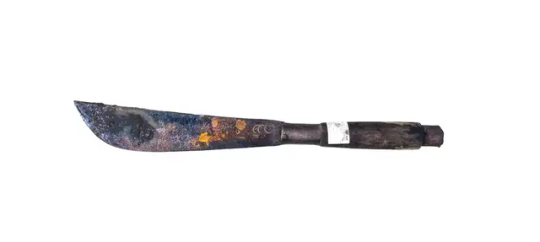
Metals such as bronze, copper, and other similar metals are commonly affected by patinas, which are tarnish-like in color.
Patina is a thin layer of film that forms on the surface of carbon steel knives over time. It's caused by exposure to oxygen and moisture, and it usually appears as a dark blue or black tint. Patina is not harmful to your knife and, in fact, some people prefer the way it looks. However, if you'd like to remove it, here are a few methods that may work.
How to remove Stains from Carbon Steel Knife?

Best and most effective methods for removing rust from carbon steel knife blades
Below are the two methods for how to remove patina from your carbon steel knife.
Using Vinegar
One popular way to remove patina is with vinegar. Simply soak a clean cloth in vinegar and use it to scrub the stained area of your knife. Rinse the knife off with water and dry it thoroughly when you're finished. You may need to repeat this process several times to completely remove the patina.
Using Baking Soda
If vinegar doesn't do the trick, you can try baking soda. Make a paste out of baking soda and water and use it to scrub the patina off your knife. Rinse the knife when you're finished and dry it thoroughly to prevent rusting. You may need to repeat this process several times for the best results.
Preventing Patina on Carbon Steel Knives

Patina can prevent rust from forming
Many people are drawn to carbon steel knives because of their beauty. The downside of this type of knife is that it's susceptible to patina. Patina is the result of the oxidation of the iron in carbon steel and it causes a dark discolouration on the surface of the metal.
While some people might find this patina to be aesthetically pleasing, others might prefer to keep their knives looking clean and new. If you fall into the latter category, here are a few tips for preventing patina on your carbon steel knives.
Store your knives in a dry place
If you live in a humid climate or if you have a lot of moisture in your kitchen, this can cause your knives to develop patina more quickly. Storing your knives in a block or in a drawer lined with a dry material like cotton can help to absorb any moisture and prevent your knives from developing patina.
Avoid using harsh chemicals
Harsh chemicals like bleach can damage the finish of your knives and accelerate the formation of patina. When cleaning your knives, stick to gentle dish soap and avoid using harsh chemicals as much as possible.
Wipe your knives down after each use
It's important to wipe down your knives after each use to remove any residue that might be on the surface of the metal. This will help to prevent a patina from forming and will also help to keep your knives looking new for longer.
Don't let your knives come into contact with other metals
If you store your knives next to other metals like copper or brass, this can cause them to develop patina more quickly. Storing them in a greased bladezap-resistant case or box not only helps to protect them from nicks and scratches but also prevents them from coming into contact with other metals that might cause them to develop patina prematurely.
Keep them polished
Polishing your blades regularly with a quality knife polish will not only help to prevent patina, but it will also extend the life of your blades and keep them looking new for longer.
Taking proper care of your carbon steel knives will help to prevent patina and keep them looking new for longer. By following these simple tips, you can enjoy using your beautiful carbon steel knives without having to worry about them developing unsightly discolouration over time!
Is Patina on knives beneficial?
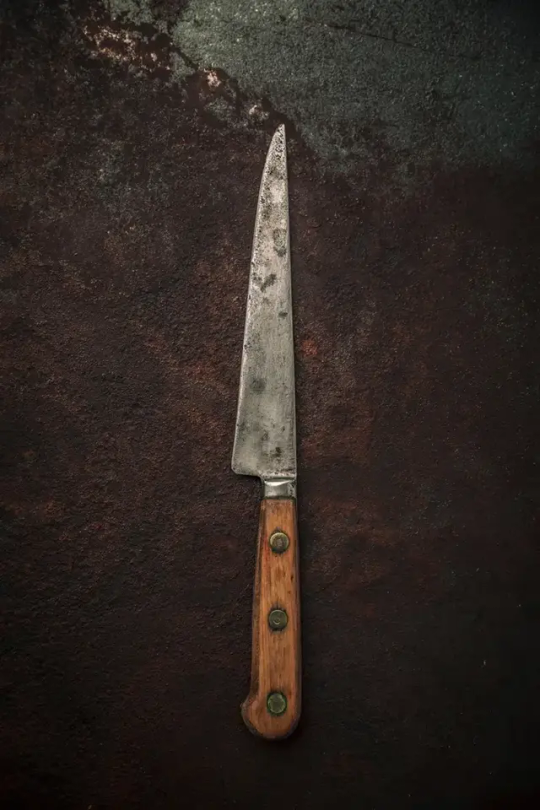
A patina is a natural protective layer on carbon steels that protects the blade and gives it a look of rough finish
For many people who use knives on a regular basis, patina can be beneficial. Over time, the patina can help to protect the metal from rust and corrosion. In addition, it can give the knife a unique appearance that can be quite attractive. However, some people prefer to avoid patina because it can make the knife more difficult to clean. Ultimately, whether or not patina is beneficial depends on personal preference.
Conclusion
If your carbon steel knife has developed patina or oxidation stains, don't despair! There are several ways you can remove them at home using common household ingredients like vinegar and baking soda. Just be sure to rinse your knife well after cleaning and dry it thoroughly to prevent rusting. We hope this article has helped you in learning how to remove stains from carbon steel knife.
Read the full article
0 notes
Text
Japanese Knife Steel Types | Detailed List

The Japanese steel industry has an extensive history. Most real Japanese knives are produced from Japanese steel, which imparts certain qualities to the blades. What are some things people have to say about Japanese Steel? Steel is made using iron ore from an isolated area in Japan mixed with carbon at smelting. Japan steel is hardened with high HC values, giving it greater sharpness and longer edge durability.
When it comes to kitchen knives, there are a lot of choices out there. In this article, we'll be looking at the different types of Japanese knife steel types and what makes them unique. We'll also discuss each of the Japanese steel types in detail. So whether you're in the market for a new chef's knife or just curious about the topic, read on!
Complete Definition of Steel
Steel is an alloy made of iron and carbon, and sometimes other elements such as chromium, manganese, molybdenum, or vanadium. The carbon content in steel determines its hardness and toughness. Generally speaking, the higher the carbon content, the harder the steel will be. However, if the carbon content is too high, the steel will become brittle and can shatter under stress.
Steel alloys are designated by a two-letter code that specifies both their chemical composition and their heat treatment. For example, "AISI 1095" is an alloy containing 0.95% carbon that has been quenched (i.e., rapidly cooled) in oil and then tempered at a lower temperature.
The first letter of the code indicates whether the alloy is ferrous (iron-based) or non-ferrous: "AISI" stands for American Iron and Steel Institute. The second letter indicates the specific alloying elements present in significant quantities.
Elements of Steel

There are certain key elements that are common to all steel types
While there are many different types of steel, they all contain certain key elements. These include carbon, chromium, manganese, molybdenum, silicon, and vanadium. The carbon content is what gives the steel its hardness and toughness. The other elements can also affect the properties of steel, as we'll see in the section on stainless steel types.
Overall All Japanese Knife Steel Types Table
The table below shows the most common types of Japanese steel and their elemental composition.
Steel TypeCarbonChromiumManganeseMolybdenumSiliconVanadiumAogami Super Steel1.2-1.6%0.5%0.4-0.8%N/A0.4-0.8%N/AAogami/Blue Steel 11.2 - 1.4%0.4%0.4-0.8%N/A0.4-0.8%N/ABlue Steel #21.0 - 1.2%0.6%0.4-0.6%N/A0.4-0.8%N/ACarbon Steel0.5 - 2.1%0.4 - 1.2%N/AN/AN/ASihrogami/White Steel #10.6 - 0.9%0.2 - 0.5%0.4-0.8%N/A0.4-0.8%N/AWhite Steel #20.8 - 1.1%0.2 - 0.5%0.4-0.8%N/A0.4-0.8%N/AVG10 Steel1 - 1.1 - 15%0.5 - 0.75%1.0 - 1.2%N/AN/AGingami #3 Steel 0.6 - 0.9 - 14%0.4-0.8%N/A0.4-0.8%N/AAUS10A Steel1.1%0.5 - 0.6%N/AN/AN/A440-A Steel1 - 1.15%1%0.8%1%N/APowdered SPG2 Steel1.3%1.0 - 1.4%N/AN/AN/APowdered R2 Steel1.45%0.35%3.30%N/A2.20%
However, Japanese steel is mainly classified as stainless steel and carbon steel. All other steels come under these two branches of knives.
What is Stainless Steel?

An iron alloy called stainless steel resists corrosion and rust
Stainless steel is an alloy that contains at least 10.5% chromium. The chromium gives the steel its corrosion-resistant properties. Stainless steel also contains other elements such as carbon, manganese, silicon, and nickel. The addition of these elements can change the mechanical properties of the steel. For example, adding more carbon makes the steel harder but less ductile.
What is Carbon Steel?
Carbon steel is an alloy of iron and carbon, and it is one of the most commonly used materials in the world. Carbon steel is widely used in a variety of applications, from automotive parts to construction materials. Its versatility, strength, and relatively low cost make it an ideal material for many different applications like the most popular one: Japanese carbon steel knives.
Stainless Steel Types
There are many different types of stainless steel, and each has its own unique properties.
Gingami #3:
This type of stainless steel is made with 13% chromium and is similar to carbon steel, but does not rust. It has a hardness of around 61 HRC and is a good choice for knives.
What is Japanese VG-10 steel?
This type of stainless steel is hard (HRC of 61) and sharp, has abrasion resistance and is difficult to chip. It also doesn't rust easily.
Powdered SPG2 steel:
This type of stainless steel is made with 62 HRC and is rust resistant. It is hard to sharpen and has a high content of carbon, chromium, tungsten, molybdenum, and vanadium.
Powdered R2:
This type of stainless steel is almost the same as powdered SPG3 steel, but it is manufactured by Kobe Steel LTD. It is rust-resistant and high-grade steel.
Carbon Steel Types
Aogami (Blue) super steel
Aogami super steel is Japan's highest quality carbon steel. It is extremely hard and is used in high-quality knives such as Santoku and Gyuto. Because of its hardness, it can hold a sharp edge for a long time.
Blue Steel #1
Aogami, or Blue #1 steel, is a type of high-carbon tool steel. It is known for its excellent edge retention and toughness, making it a popular choice for knives and other cutting tools. Aogami steel is produced by adding chromium and tungsten to traditional tool steel recipes. This gives the steel greater wear resistance and hardness, while still maintaining good toughness.
Aogami steel is often used in combination with other steel to create Damascus steel. When forge-welded together, the different steels create a layered pattern that is both visually stunning and functional. The hard Aogami core helps to improve the edge retention of the finished knife, while the softer outer layers help to protect the edge from chipping.
Tamahagane Steel
Tamahagane steel is a type of traditional Japanese steel that has been used for centuries to create some of the country's most iconic swords and knives. The steel is made from a special type of iron sand that is found in only a few places in Japan. The sand is smelted in a furnace that is stoked with charcoal, and the resulting steel is then shaped and tempered through a variety of methods. Today, tamahagane steel knife is still prized for its beauty and strength, and it continues to be used by master craftsmen to create high-quality knives and swords.
White Steel # 1 Or Shirogami Steel
Shirogami(White) #1 steel is a type of carbon steel typically used for knives and other cutting tools. It is highly pure, with few impurities, and contains a high amount of carbon. This makes it extremely hard and durable, ideal for use in knives and other cutting tools. However, the high carbon content also makes the steel somewhat difficult to work with, and it can be brittle if not properly heat treated. Overall, Shirogami(White) #1 steel is an excellent choice for knives and other cutting tools due to its hardness and durability.
What is Yasugi Steel?
Yasugi Steel is a type of steel that was developed in Japan. It is known for its strength and durability, as well as its resistance to corrosion. Yasugi Steel is often used in the construction of bridges and other structures that require high levels of strength and durability.
Steel is made by combining iron with other metals, such as chromium, manganese, and silicon. This combination creates steel that is both strong and resistant to corrosion. In addition, the steel is also heat-treated, which further increases its strength and durability. As a result of these properties, Yasugi Steel is an ideal choice for use in a variety of applications.
Best Steel For Japanese Knives

Multipurpose Japanese knife for professional use
Japanese knives are known for their sharpness and durability, and they are a popular choice among both professional chefs and home cooks. While there are many different types of steel used in knife making, some steels are better suited for Japanese knives than others. For example, carbon steel is often used in traditional Japanese knives because it can be sharpened to a very fine edge.
However, carbon steel can also be susceptible to rust and wear over time. Stainless steels are another popular option for Japanese knives, as they are less likely to rust and easier to care for. However, stainless steels are not as easy to sharpen to a very fine edge. Ultimately, the best steel for Japanese knives depends on the intended use of the knife and the preferences of the user.
Molybdenum steel vs VG10 steel: which is better?
Molybdenum steel is known for being very hard, making it an ideal choice for knives that will be used for chopping and slicing. It is also less likely to rust than other types of steel. However, molybdenum steel can be difficult to sharpen, and it may chip more easily than VG10 steel.
VG10 steel, on the other hand, is softer than molybdenum steel but harder than most other types of stainless steel. This makes it a good choice for knives that will be used for slicing and dicing. VG10 steel is also easier to sharpen than molybdenum steel and is less likely to chip. However, it may not be as durable as molybdenum steel in terms of resistance to wear and tear.
Is Japanese steel good for knives?
Yes, Japanese steel is often chosen for knives because of its durability and ability to take a sharp edge. However, there are different types of Japanese steel, so it's important to choose the right type of steel for the knife's intended use. For instance, carbon steels are good for sharpness, while stainless steel is rust-resistant.
Is Japanese steel good quality?
Japanese steel is known for its quality and is often used in knives and other cutting tools. The steel is made through a process of combining iron and carbon, which makes it strong and durable. It's no wonder that Japanese steel is so highly regarded!
Conclusion | Japanese Knife Metal Types
There are a few Japanese knife steel types, each with its own set of benefits and drawbacks. The most common types of Japanese knife steel include carbon steel, stainless steel, and Yasugi steel.
Carbon steel is known for its sharpness and durability, but it can also be brittle if not properly heat treated. Stainless steel is less likely to rust and easier to care for, but it is not as easy to sharpen to a very fine edge. Yasugi steel is known for its strength and durability, as well as its resistance to corrosion. Ultimately, the best steel for Japanese knives depends on the intended use of the knife and the preferences of the user.
Hope this article helped you learn about the different types of Japanese knife steel. If you have any questions, feel free to leave a comment below!
FAQs | Japanese Steel Types
What is the hardest Japanese steel?The hardest Japanese steel is White steel # 1 because of the high carbon contents that give it an HRC of around 63.What is Japan's rarest steel?Japan's rarest steel is Tamahagne steel, which is only found in a few sword smiths.Is VG10 hard to sharpen?VG10 is premium steel and easier to sharpen than most stainless steel. It can take a very sharp edge within a few minutes.
Japanese super steel knife, extraordinary performance, and edge retention
Every component of this knife feels well-designed, from the materials used to the finish.
Read the full article
0 notes
Text
How to Clean Rust Off Damascus Steel Knives?
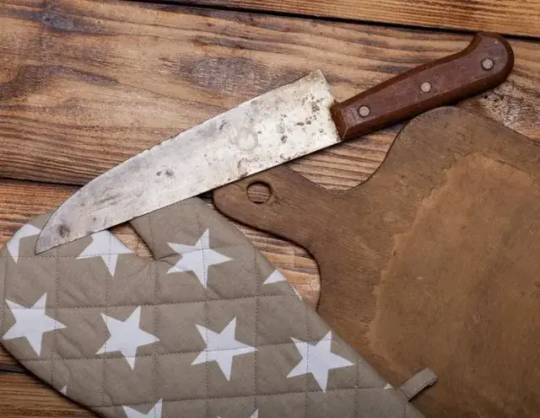
If you’re a knife collector, you probably know that rust is the enemy of your knife. Damascus steel knives are some of the most beautiful and well-crafted knives on the market. However, they are also prone to rust if not taken care of properly. It'll eventually rust if you don’t take care of your knife.
4 Simple Ways To Remove Rust From Damascus Steel Knives
In fact, there are numerous types of rust, and some are harder to remove than others. If you’re looking for an easy guide on how to clean rust off Damascus steel knives, then this post is for you.
Why Do Knives Rust?

a rusted knife
Knives rust because of the moisture in the air. When you cut meat, it can get inside the knife. If you use it often, the moisture in the meat will react with the metal of the knife and cause it to rust. To help keep your kitchen knives sharp, place them in a dry place, such as a drawer. If you’ve a kitchen cabinet, you should put your knives inside a plastic bag. It will keep the moisture out.
Guide to Clean a Damascus Steel Knife
There are different kinds of rust on a knife. At times, it may be challenging to get rid of them all. The best way to clean rust from Damascus steel knives is to start with the surface that is most likely to show first. To begin, rub a little bit of oil on your knife's blade. This will help you to identify the rust and to spot it quickly. It’s also important to note that it is best to clean your knife before storing it.

clean your damascus knife in a safe and easy way
1. Lemon Juice Method
To remove rust from your knife, you can either use lemon juice directly or dilute it with water. You should start by rubbing lemon juice on the surface of the knife. After that, rub it in a circular motion. Don't rub too hard or too fast. Make sure that you don't leave the lemon juice on the blade for more than ten minutes. Leaving it for more time can damage your knife.
2. Vinegar Method
Vinegar is another easy and most working way to remove rust. It is effective because vinegar is acidic just like lemon juice. Start by rubbing the knife in the vinegar. You can use a cotton ball or cloth to apply the vinegar. Rub the knife in a circular motion. Make sure you rub gently and slowly. Wait until the vinegar has dried.
3. Soda Paste Method
Baking soda is another good way to clean rust from your knife. Mix some baking soda with water to make a thick paste that we'll apply to the knife. Apply that soda paste to your knife for about 10 minutes. Then, wash it with warm water gently to remove any leftovers.
4. How to Get Rid of Rust on Damascus Steel using WD-40 Rust Remover?

clean rust from steel knives by different methods
I like removing rust using this WD-40 rust remover method because it allows you to clean your knife in a safe and easy manner. It can be a quick and effective way to remove rust from your knife.
Avoid using WD-40 as a lubricant. Instead, spray it on the blade of the knife.
Spray the rusty area of the knife with WD-40. Then, use very fine sandpaper to gently remove the rust. You’ve got to make sure you don't touch the edges of the canvas to clean it. Then wipe it using a clean cloth and then let it dry.
What Is Damascus Steel?Damascus steel knives are very durable and strong. These knives were developed thousands of years ago in Egypt and Syria. They were made from steel that was produced from pure iron ore. The technique of producing them is called the "hammered and folded" process. You will find it in many ancient cultures. Today, you can still buy Damascus steel knives in some shops and online. Many people love these knives because they are so durable and strong.
How to Polish Damascus Steel?Polishing a Damascus steel knife is very easy. It is simply cleaning the knife. You should first clean it with water and then with soap. Then, you should put the blade of your knife in a dish and rub it with a soft cloth. This is the most important step. Do not use abrasives or steel wool because they will ruin the finish.
How Do I Prevent Rust From Reappearing on my Knife?

best way to prevent rust knife
The best way to prevent rust from reappearing on your Damascus steel knife is to soak the knife in water after washing it. Washing the knife with soap and hot water will help to remove any oils that may be present on it. Always remember to completely dry your knife before storing it. You should store your Damascus steel knife in a dry place. Your knife will save longer from rust if you keep it clean and dry.
Tips: You will need to wash your Damascus steel knife at least once every week. It is important to do this regularly because the chemicals used in cleaning will wear down the steel in time. You should also soak your knife in water after washing it, and then dry it thoroughly before storing it. You should store your Damascus steel knife in a dry place.
Conclusion | How to Clean Rust Off Damascus Steel Knives?

rust removal technique step by step
The article gives you step-by-step instructions on how to rust off Damascus steel knives. All these steps and methods can be applied to any knife. You’ll also be able to clean any kind of knife with this technique. You should remember to follow these steps every time you clean your knife.
This will help you to ensure that rust doesn't appear on your knives. A knife that has rust on it will no longer be as sharp as the one that was new. If you don't clean it, you might even damage the knife.
I hope you’ve found this post helpful. Please share your experience if you've used any of the above methods. I'd love to hear about your experience with the results you got with rust removal.
Thanks for reading!
Read the full article
0 notes
Text
Everything About Ceramic Knife - Are Ceramic Knives Good For Sushi

Imagine you are in the market for a new kitchen knife. You've heard that ceramic knives are a great option and you're wondering if they would be a good fit for sushi. You do some research and find that, yes, ceramic knives can be good for sushi.
However, you're unsure if they are the best option. You have some questions about how they compare to traditional steel knives and whether or not they are as durable. It is also important to understand how to maintain them to ensure they last as long.
Are ceramic knives good for sushi? Many people ask this question when looking to purchase a new kitchen knife. Ceramic knives are made of a material other than steel and are known for being sharper and longer lasting. They do not rust or corrode, making them ideal for slicing raw fish.
However, they are more brittle than traditional knives and can break if dropped. So, are ceramic knives good for sushi? This article will discuss the pros and cons of using ceramic knives for this purpose in order to help you make an informed decision
What are Ceramic Knives and What are They Made of?
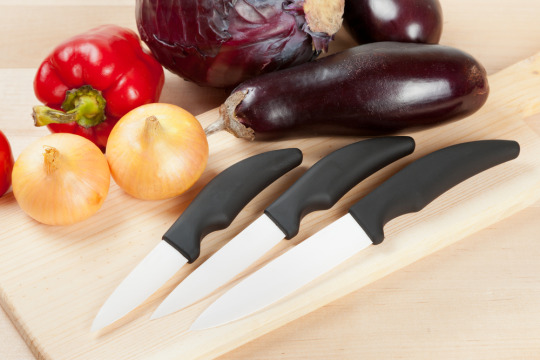
ceramic knife Use only with a plastic or wood cutting board
A ceramic knife is a knife with a blade made from ceramic material. Ceramic knives are extremely hard and wear-resistant, making them ideal for slicing through tough materials like meats and vegetables. Ceramic knives are also sharper than their metal counterparts, which makes them perfect for precise cutting. However, ceramic knives are also brittle and can easily break if dropped or used to cut through hard objects.
As a result, they must be handled with care. In terms of composition, most ceramic knives consist of zirconium dioxide, which is a strong and durable material. Zirconium dioxide is also chemically inert, meaning it won't rust or corrode over time. Ceramic knives, therefore, are easy to maintain. That’s why Ceramic knives are increasingly in demand by professional chefs and home cooks
Are Ceramic Knives As Good as Steel?

Ceramic blades are stronger and last longer than steel blades
When it comes to kitchen knives, there are a variety of options available. Perhaps the most popular choice is the stainless steel knife. Steel knives are durable and easy to care for, and they hold their edge well. However, they can also be quite heavy and may require sharpening more frequently than other types of knives.
Ceramic knives offer a more modern option than traditional steel knives. They are lighter than traditional steel knives, which makes them more comfortable to use for longer periods. In addition, ceramic knives hold their edge ten times longer than steel knives, meaning they will need to be sharpened less often.
Finally, ceramic knives are non-reactive, so they won't cause food to discolor or develop off-flavors when coming into contact with acidic ingredients. While ceramic knives do have a higher initial cost than steel knives, their long-term durability and performance make them an excellent investment for any serious cook.
Are ceramic knives good for sushi?

Nonstick ceramic coating makes it easy to slice sushi
As we mentioned before, ceramic knives are a good option for sushi because they are extremely sharp and will not corrode or react with acidic ingredients. In addition, ceramic knives are lightweight and easy to maneuver, making them ideal for precision cutting. However, because they are brittle, ceramic knives must be handled with care.
If you are looking for a knife that is both sharp and durable, then a ceramic knife is a good option for you. However, if you are not comfortable handling a brittle knife, then a steel knife may be a better choice.
What are the benefits of using a ceramic knife for sushi?

The longer, deeper ceramic chef's blade is great for slicing, dicing, and chopping
A ceramic knife is a great choice for making sushi. Ceramic knives are sharper than steel knives and won't dull as fast. This means that you can achieve a precise cut with each slice, which is important when preparing sushi.
When it comes to sushi, there are a few things that are important: freshness, precision, and delicate flavors. A ceramic knife can help you achieve all of these things. Because ceramic is not affected by acids or juices, it helps to keep sushi fresher for longer.
Ceramic knives are non-reactive and will not cause food to discolor or develop off-flavors. This is important when working with sushi, as the fish is often very delicate and can easily be damaged.
You can easily slice through thin vegetables without any problem.
Finally, ceramic knives are lightweight and easy to maneuver. This is important when cutting sushi, as you want to be able to slice through the fish without crushing it.
What type of knife is used for sushi?
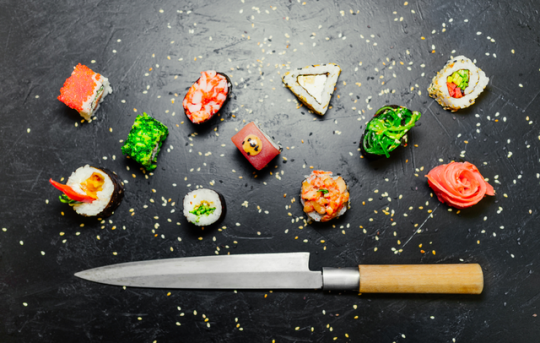
Prepare the perfect cuts of sushi or sashimi with the Yanagiba Knife
Traditionally, sushi is prepared with a knife called a Yanagi-ba. Yanagi-ba knives are long and thin, with a single bevelled edge. The blade is also flexible, which makes it easy to maneuver around delicate ingredients. In addition, Yanagi ba knives are designed to maintain their sharpness longer than other types of knives, which is essential for creating perfect cuts of sushi.
While Yanagi-ba knives are the traditional choice for sushi, any type of sharp knife can be used. Ceramic knives are a good option for sushi because they are extremely sharp and will not react with acidic ingredients. In addition, ceramic knives are lightweight and easy to maneuver, making them ideal for precision cutting.
- https://kitchenvillas.com/why-are-sushi-knives-one-sided/
You can also use a steel knife for sushi, although it is important to choose a high-quality knife that is extremely sharp. Steel knives are durable and easy to care for, but they can be quite heavy and may require sharpening more frequently than other types of knives.
The most important thing is to choose a knife that you are comfortable using. If you are not comfortable with a ceramic knife, then a steel knife may be a better choice. However, if you are looking for a sharp and durable knife, then a ceramic knife is a good option.
How to Care for Your Ceramic Knife so it Lasts Longer?
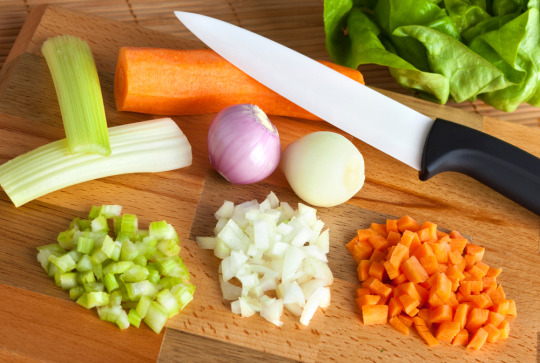
Tips and tricks for proper knife care
With proper care, your ceramic knife can last for many years. Here are a few tips to help you keep your knife in good condition:
- Always store your knife in a safe place. A ceramic knife is brittle and can break if dropped. It is best to store your knife in a sheath or protect it with a blade guard.
- Avoid cutting through hard ingredients. Ceramic knives are designed for slicing through soft ingredients such as fish, vegetables, and fruit. Do not use your knife to cut through bones, frozen food, or hard cheese.
- Avoid using your knife on a cutting board made of glass or ceramic. These materials can dull the blade. Instead, use a cutting board made of wood or plastic.
By following these tips, you can help ensure that your ceramic knife will last for many years to come.
Why do Ceramic knives break?
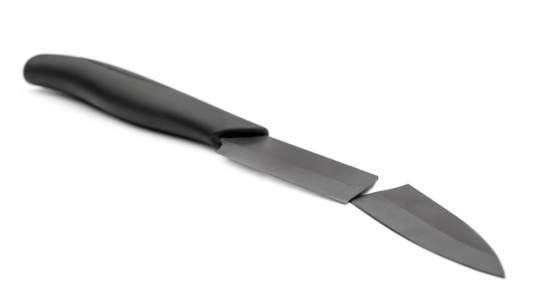
Ceramic knives can break on hard surface
Ceramic knives are made of brittle material and can break if dropped or if they come into contact with a hard surface. In addition, ceramic knives are not as strong as steel knives and can chip or break if used to cut through hard ingredients like bone or frozen food. For these reasons, it is important to take care when using and storing your ceramic knife.
If you accidentally drop your ceramic knife, inspect it for chips or cracks. The blade must be replaced if it is damaged.
Keep your knife safe and use a cutting board that won't dull it. In addition, avoid cutting through hard ingredients and bones.
By following these tips, you can help ensure that your ceramic knife will last for many years to come.
What is the Most Disadvantageous Thing About Ceramic Knives?
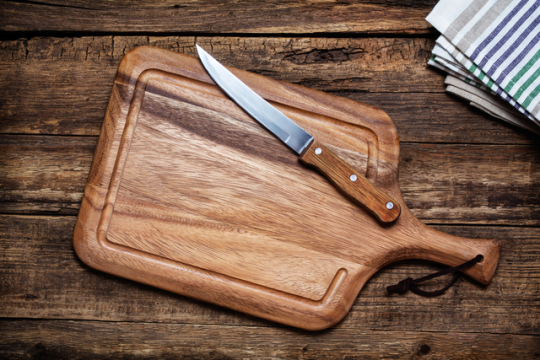
disadvantages of ceramic knife
Ceramic knives have a number of advantages, but they also have a few disadvantages.
One disadvantage of ceramic knives is that they are brittle and can break if dropped. In addition, they are not as strong as steel knives and can chip or break if used to cut through hard ingredients.
Another disadvantage of ceramic knives is that they require special care. For example, you should always store your knife in a safe place and use a cutting board that will not dull the blade. In addition, avoid cutting through hard ingredients and bones.
Finally, ceramic knives can be more expensive than traditional steel knives.
Despite these disadvantages, ceramic knives offer a number of advantages, including being extremely sharp and durable. If you take care of your knife, it can last for many years.
FAQs
Can a ceramic knife cut a finger?Yes, a ceramic knife can cut your finger if you're not careful. The blades are very sharp and can easily slice through the skin.Are ceramic knives good for the dishwasher?No, you should not put your ceramic knife in the dishwasher. The harsh chemicals and high temperatures can damage the blade.Are ceramic knives good for sushi?Yes, ceramic knives are good for sushi because they are sharp and durable. In addition, they do not rust or corrode, which is important when dealing with raw fish.Are Sushi Knives Safe?Yes, these knives are safe enough to be used if you follow the care instructions.
Conclusion | Are Ceramic Knives Good For Sushi

Traditional steel knives are sharper and longer lasting
Ceramic knives are known for being sharper and longer lasting than traditional steel knives. They do not rust or corrode, making them ideal for slicing raw fish. However, they are more brittle than traditional knives and can break if dropped. A ceramic knife is a good option for sushi because it is sharp and durable. In addition, they do not rust or corrode, which is important when dealing with raw fish.
I hope you enjoyed the article. If you have any questions, please feel free to contact us.
Read the full article
0 notes
Text
Stainless Steel and Damascus Steel Difference

Damascus steel and stainless steel are two types of steel that are commonly used in a variety of applications. But what is the difference between Damascus steel and stainless steel? What are their compositions? And what are some of the unique features of each type of steel? In this article, we'll answer all your concerns and more!
Damascus steel can be described as a kind of steel traditionally used to make knives and swords. It is characterized by its distinctive wavy or rippled pattern, which is created by folding and forge-welding layers of iron and steel. Damascus steel was also known for being extremely tough and resistant to breakage.
Stainless steel On the other hand is a form of steel that has a minimum of 11 percent of chromium. This is what makes it stronger against corrosion than Damascus steel. The stainless steel is non-magnetic. That means it is not attracted to magnetic objects. Additionally, stainless steel is less likely to discolor or stain than Damascus steel.
Key Differences
So, what are the key differences between Damascus steel and stainless steel? A major difference between Damascus and stainless steel is characterized by its wavy or rippled pattern, while stainless steel is non-magnetic and less likely to discolor or stain. Damascus steel is also more resistant to breakage than stainless steel. So, if you're looking for tough and durable steel, Damascus steel is a good option. Stainless steel is a better option if you're looking for steel that is less likely to discolor or stain.
What materials is Damascus Steel made of?

High carbon steels and nickel alloyed steels are often used in Damascus steel
Damascus steel is made of iron and steel. The exact composition varies depending on the specific Damascus steel, but typically, it contains about 0.60-0.90% carbon. Damascus steel also has other metals like molybdenum, cobalt, nickel, and vanadium.
What is the difference in hardness between Damascus steel and stainless steel?
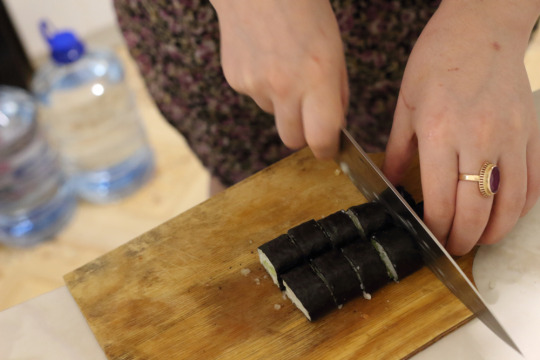
Damascus knives generally don't last as long as good quality stainless steel knives.
Damascus steel is in fact harder than stainless steel. This is due to the high carbon content in Damascus steel, which makes it harder and more resistant to breakage. Stainless steel, on the other hand, contains chromium, which makes it more resistant to corrosion but less resistant to breakage.
Damascus steel is an ideal choice for applications that require tough and durable steel. Stainless steel is a better choice for applications that require steel that is less likely to discolor or stain.
What is the difference in durability between Damascus steel and stainless steel?
Damascus steel is more durable than stainless steel. This is because Damascus steel contains carbon, which makes it harder and more resistant to breakage. Stainless steel, on the other hand, contains chromium, which makes it more resistant to corrosion but less resistant to breakage.
Damascus Steel vs Stainless Steel A Difference in resistance to corrosion
Damascus steel has a lower susceptibility to corrosion than stainless. The stainless steel has chromium which helps it resist corrosion. Damascus steel doesn't contain chromium, which makes it more vulnerable to corrosion and rust.
How do Damascus Steel And Stainless Steel Differ By Appearance?
Damascus steel has Damascus patterns while stainless steel is just a shiny surface. Damascus designs are created due to impurities that are present in the wootz steel blocks where the Damascus steel melted. Layering the blades repeatedly during forging produced the Damascus blade pattern. Modern metallurgists use different materials to reproduce the signature Damascus patterns.
Damascus Knives vs Stainless steel knives: Which is the Better Option?
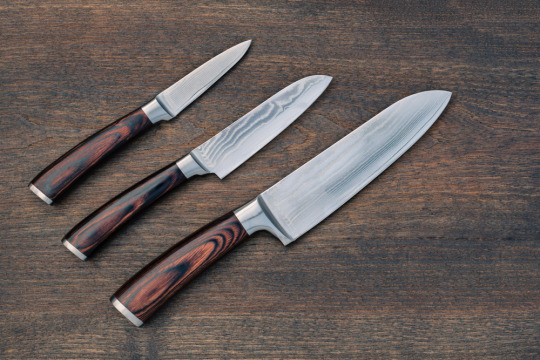
As a general rule, stainless steel knives last longer and are easier to maintain than damascus knives
Damascus steel knives are better than stainless steel knives in terms of durability and resistance to breakage. Damascus steel contains carbon, which makes it harder and more resistant to breakage. Stainless steel, on the other hand, contains chromium, which makes it more resistant to corrosion but less resistant to breakage. Stainless steel knives are also less likely to discolor or stain than Damascus knives.
Read More: https://kitchenvillas.com/damascus-steel-knives/
Why is Damascus Steel called Damascus?
The Damascus steel blades were created in the city of Damascus, Syria. The steel received its name because of the town the first place it was forged. Damascus blades are known for their distinctive patterns, which are formed by the layering of different types of metal during the forging process.
How Damascus Steel Is Made?
The process of making Damascus steel begins with a block of iron and steel. The iron and steel are heated to a high temperature and then hammered into thin sheets. These sheets are then forged-welded together to create a Damascus billet. The billet is then reheated and forged into shape. Once the desired shape is achieved, the Damascus steel is cooled in oil or water to harden it.
How Stainless Steel Is Made?
Stainless steel is produced by mixing iron with other elements, like nickel and chromium, in an unchangeable or fixed proportion. This creates a corrosion-resistant material that is durable and easy to maintain.
Conclusion | Damascus Steel VS Stainless Steel
So, Damascus steel is harder and more resistant to breakage than stainless steel. Stainless steel is more resistant to corrosion but less resistant to breakage. Damascus steel is less resistant to corrosion than stainless steel.
Damascus knives are a better option for applications that require a tough and durable knife while stainless steel knives are a better option for applications where the knife is less likely to discolor or stain.
I hope you find this article informative. For any concerns, post a question in the comments below. Thank you for taking the time to read!
Read the full article
0 notes
Text
Everything You Need To Know About Butcher Knives - Types, Usage, And Features

Butcher knives are a type of kitchen knife that is specifically designed for cutting meat. They come in a variety of shapes and sizes, but all are meant to provide maximum control and comfort when slicing through raw or cooked meat. Butcher knives are also incredibly efficient, allowing the user to execute a wide range of tasks with ease.
In this article, we'll discuss the different types of butcher knives, their uses, and why they are so popular among chefs and home cooks alike.
What is a Butcher Knife Used for?

It is best to use a butcher knife if you need to cut large pieces of meat into smaller pieces.
Large and razor-sharp, a butcher knife is made specifically for chopping meat. Typically, the blade is curved, which makes it simpler to cut through big chunks of meat. Typically, butcher knives have a strong handle that is comfortable to use even with moist hands. Any cook who wishes to prepare their own meat should have this kind of knife on hand.
In addition to being used in butcher shops, butcher knives are also a valuable tool for home cooks who frequently work with large cuts of meat. Butcher knives can be used for more than just cutting meat. The broad, razor-sharp blade can also be used to slice bread and chop vegetables. In a pinch, the blade can even be used as a screwdriver.
To read more about cutting Meet:
https://kitchenvillas.com/best-knives-for-cutting-raw-meat/
However, it is important to use caution when using a butcher knife for anything other than cutting meat, as the blade is very sharp and can easily cause injuries. When choosing a butcher knife, it is important to select a size and style that will suit your specific needs.
The Exquisite Efficiency of Butcher Knives
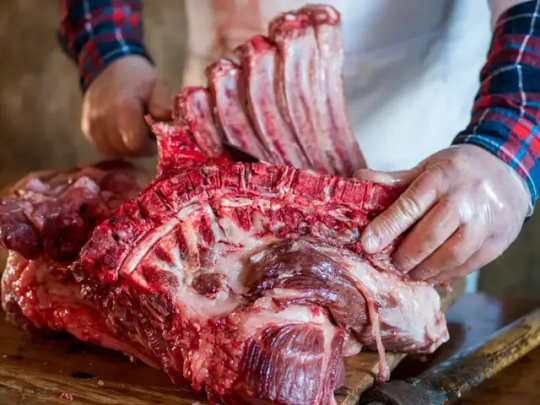
Smooth and long slices are made possible by the length of the butcher knife's blade
Butcher knives are popular among both professional chefs and home cooks for their versatility and efficiency. Even the toughest portions of meat are simple to cut through because of the wide, sharp blade. The curved blade also provides greater control when slicing through thick pieces of meat. And the thick handle ensures a comfortable grip, even when your hands are wet.
Control
Butcher knives provide greater control when cutting through meat, due to their large, sharp blades and curved shapes. This makes them ideal for precision slicing and chopping. The curved blade also makes it easier to slice through thick pieces of meat.
Comfort
When you are using a butcher knife, it is important to be comfortable. The thick handle provides a comfortable grip, even when your hands are wet. The blade is also curved, which makes it easier to control the knife and prevents your hands from slipping. This makes butcher knives ideal for precision slicing and chopping.
Agility
Butcher knives are designed for maximum comfort and agility. The large, sharp blade and thick handle make it easy to control the knife while slicing through meat.
Since butcher knives have been used for generations, their use is becoming more and more common as more people become aware of their advantages. If you're thinking about adding a butcher knife to your kitchen collection, read on to learn everything you need to know.
Different Types Of A Butcher Knife

A variety of traditional knives, such as butcher knives, cleavers, carving knives, and breaking knives
There are seven different types of butcher knives, each designed for a specific purpose.
The Boning Knife
This knife is used for removing bones from meat. It has a sharp, pointed tip that allows for precision work.
A small, lightweight knife called a boning knife is ideal for removing bones from meat. Its pointed, sharp tip makes it simple to fit into small locations, and its small, precise blade guarantees accurate cuts. Boning knives are the ideal length for little hands because they are typically 6 to 8 inches long.
The Traditional Butcher's Knife
This is the most versatile of all the butcher knives. From slicing meat to chopping vegetables, it is useful for many tasks. A broad, multipurpose knife, the classic butcher's knife can be used for everything from slicing meat to chopping vegetables.
It has a wide blade and a blunt end that make it perfect for heavy-duty work. Traditional butcher's knives come in both 8 and 10-inch lengths, making them perfect for kitchen use.
The Skinning Knife
As the name suggests, this knife is used for removing the skin from the meat. Its blade is curved and razor-sharp, which makes it simple to penetrate the skin without harming the meat itself.
The skinning knife is a small, curved knife that is designed specifically for removing the skin from the meat. Its sharp blade makes it easy to get under the skin without damaging the meat itself. Skinning knives are usually between 6 and 8 inches long, making them perfect for smaller hands.
The Cimeter Knife
This knife is used for slicing thick cuts of meat. It has a long, curved blade that allows for long, even strokes.
The cimeter knife is a long, curved knife that is designed for slicing thick cuts of meat. Its long blade allows for smooth, even strokes, and its curved design ensures maximum control. Cimeter knives are usually between 10 and 14 inches long, making them perfect for kitchen use.
The Breaking Knife
Using this knife, huge slices of meat may be divided into smaller pieces. It can easily cut through difficult foods because of its hefty, blunt blade. A big, dull knife called a breaking knife is used to chop up huge portions of meat into smaller pieces.
Its heavy blade ensures maximum force with every cut, and its blunt end prevents accidental injuries. Breaking knives are usually between 8 and 12 inches long, making them perfect for larger hands.
The Steak Knife
This knife is used for cutting steak and other thick cuts of meat. It has a short, serrated blade that can handle both tender and tough meats.
The steak knife is a small, serrated knife that is designed for cutting steak and other thick cuts of meat. Its short blade makes it easy to control, and its serrated edge ensures a clean cut. Steak knives are usually between four and six inches long, making them the perfect size for smaller hands.
To read more about steak knife: https://kitchenvillas.com/dinner-knife-vs-steak-knife/
The Meat Cleaver
This knife is used for chopping the meat into smaller pieces. It has a heavy, blunt blade that can handle tough meats with ease.
The meat cleaver is a large, blunt knife that is designed for chopping meat into smaller pieces. Its heavy blade can handle even the toughest cuts of meat, and its blunt end prevents accidental injuries. Meat cleavers are usually between eight and 12 inches long, making them perfect for larger hands.
How to choose the Right Butcher Knife For Your Needs?
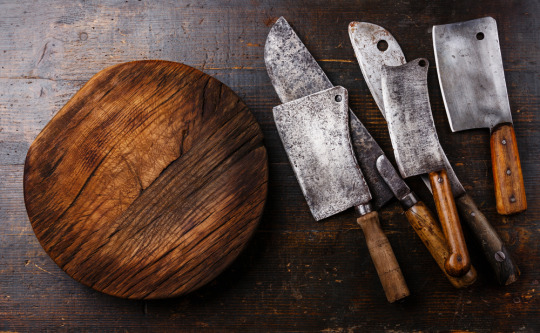
If you choose a butcher knife, make sure it has a substantial weight to it
When it comes to choosing the right butcher knife for your needs, there are a few things you need to consider. First, think about the type of meat you'll be working with most often. If you're mostly slicing meat, then a boning knife or a traditional butcher's knife will be your best bet. If you're mostly skinning or breaking down meat, then a skinning knife or a breaking knife will be your best choice. Finally, if you're going to be doing a lot of chopping, then a meat cleaver is your best option.
No matter what type of butcher knife you choose, make sure it's the right size for your hand. Most knives come in both eight and ten-inch sizes, so you can find one that's comfortable for you to use. And always make sure to keep your knives
FAQs | Butcher Knives
What is a Butcher Knife used for?A butcher knife is an all-purpose kitchen knife that can be used for everything from slicing meat to chopping vegetables.What are the different types of butcher knives?There are seven different types of butcher knives: the boning knife, the traditional butcher's knife, the skinning knife, the cimeter knife, the breaking knife, the steak knife, and the meat cleaver. What is the best butcher knife for kitchen use?The traditional butcher's knife is the most versatile of all butcher knives. It can be used for everything from slicing meat to chopping vegetables.What is the best butcher knife for smaller hands?The skinning knife is a small, curved knife that is designed specifically for removing the skin from the meat. Its sharp blade makes it easy to get under the skin without damaging the meat itself.What is the best butcher knife for larger hands?The breaking knife is a large, blunt knife that is designed for breaking down large cuts of meat into smaller pieces. Its heavy blade ensures maximum force with every cut, and its blunt end prevents accidental injuries.
Conclusion
Butcher knives are an essential part of any kitchen, and there is a knife for every task. Whether you need a boning knife for removing the skin from meat or a breaking knife for chopping the meat into smaller pieces, there is a butcher knife that will suit your needs. With so many different types of butcher knives available, there is sure to be one that is perfect for you. So, what are you waiting for? Get chopping!
Did you find this article helpful? If so, please share it with your friends and family. And don't forget to check out our other articles on kitchen knives for more information. Thanks for reading!
Read the full article
0 notes
Text
How To Sharp Serrated Knife?
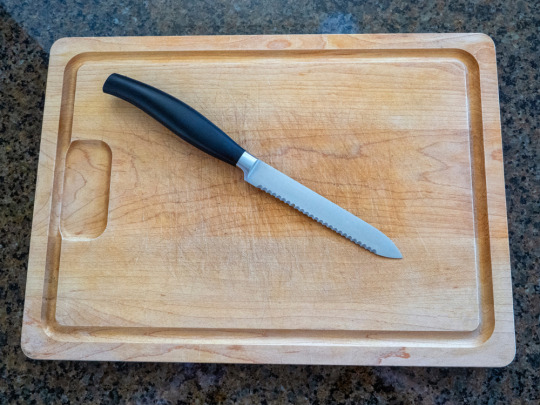
Serrated Knife: Do you have a serrated knife that is no longer sharp? In this detailed guide, we will teach you how to sharpen it using a variety of methods like an electric sharpener, Dremel, or whetstone, etc.
Slicing bread, tomatoes, and other kinds of food require a sharp serrated knife. During this discussion, we will also answer a few common questions regarding serrated knives. Below is a complete guide on how to sharpen a serrated knife with different means.
Serrated Knife

Every home cook should have a proper serrated knife
The blade of a serrated knife seems like saw teeth. These saw teeth-like structures are known as serrations. These serrations make it easier to cut through tough or crusty surfaces like bread, tomatoes, and meat. A serrated knife is a knife with a saw-toothed blade, which can be used for a variety of tasks such as slicing bread or cutting through tough meat.
It is easier to slice through food without crushing it because the teeth of the blade help hold onto the food. Tough materials like rope or plastic can also be cut through a sharp serrated knife. While they are not always the sharpest knives around, their unique blade design helps to make up for this lack of precision. Every cook knows that a serrated knife is an essential kitchen tool.
In contrast to traditional knives, serrated knives are more difficult to sharpen. However, with a little patience and the right tools, you can easily sharpen your serrated knife at home.
Different Methods to Get A Swifty Sharp Serrated Knife

Serrated knives can be sharpened with a rod or with a flat edge sharpener
Serrated knives can be sharpened in many ways, but the best way is with a honing rod. The best and recommended way to sharpen a knife is by using a honing or sharpening rod manually rather than using an electric sharpener or a Dremel.
Sharpen a Serrated Knife with a Honing Rod

You can maintain your knives like a professional at home with the Honing Rod
Here's what you'll need to get a sharp serrated bread knife:
- A honing rod (also called sharpening steel)
- A serrated knife
- A cutting board
- A towel or cloth
First, find a honing rod that's the right size for your knife. The rod should be about as long as the blade of your knife. If you’re not sure which length of the rod to use, go with a longer rod.
Next, set your cutting board on a towel or cloth to keep it from slipping. Hold honing rod and the knife in alternative hands. Set the knife blade at a 20-degree angle against the rod.
For right-handed people, this means holding the rod in your left hand and the knife in your right. For left-handed people, it's the reverse.
Now, using even pressure, run the blade of the knife down the length of the rod. Ensure the 20-degree angle while sharpening throughout the whole process. Repeat the above process on each side of the blade about 15 times.
If you're having trouble keeping a consistent angle, try using a sharpening guide. This is a tool that helps you keep the blade at the right angle as you sharpen.
If you aren't sure the blade has been sharpened, put it to the test by cutting a piece of bread or tomato with it. Until you get the desired sharpness, repeat the process.
Take advantage of the knowledge you gained about sharpening a serrated knife with a honing rod now! Practicing a few times will make you a pro at slicing bread and tomatoes.
Sharpen a Serrated Knife with an Electric Sharpener

User-friendly and fast, electric knife sharpeners can sharpen a variety of blades
Electric sharpeners are quite easy and the best ones to sharpen serrated knives. The instructions that come with your electric sharpener can also tell you how to sharpen a serrated knife. Most sharpeners have multiple slots for different types of blades, so be sure to choose the one that is meant for serrated knives.
Once you have selected the right slot, hold your knife at a 90-degree angle to the sharpener and run the blade through. Be patient while sharpening because going hurry can be useless.
After a few passes, your knife should be nice and sharp. If it is not as sharp as you would like, simply run it through the sharpener a few more times. It’s important not to damage your blade by overdoing it.
Sharpen a Serrated Knife with Dremel

A Dremel is too aggressive to use to sharpen a knife
First, you'll need to gather the following supplies:
- Dremel rotary tool
- Dremel sharpening stone
- Serrated knife
Now that you have everything you need, let's get started.
Step # 1: Turn on your Dremel rotary tool and hold it against the side of the serrated knife blade.
Step # 2: Slowly move the Dremel up and down the length of the blade, being careful not to apply too much pressure.
Step # 3: After a few passes, you should start to see a burr forming on the edge of the blade.
Step # 4: Once you've created a burr all along the edge of the blade, it's time to move on to the next step.
Step # 5: Turn off the Dremel and use a sharpening stone to remove the burr from the edge of the blade.
Step # 6: Start by holding the stone against the side of the blade and moving it up and down.
Step # 7: Once you've gone over the entire edge of the blade, it's time to test it out.
Step # 8: Try slicing through a piece of paper or cutting something with your newly sharpened knife. If it feels sharper than before, then you're done!
How to Tell if a Serrated Knife is Sharp?

Sharpen your serrated knife at home by giving it a few tests
If you are not sure if your serrated knife is sharp, there are a few tests you can do at home. One is to try slicing a paper. If the blade tears the paper or leaves jagged edges, then it is time to sharpen your knife.
Another test you can do is to slice through a tomato. A sharp serrated knife should be able to effortlessly glide through the skin without squishing the fruit. If your knife is struggling to make it through the skin, or if it leaves behind a ragged edge, then it is time to sharpen the knives blade.
How to Keep a Serrated Knife Sharp?
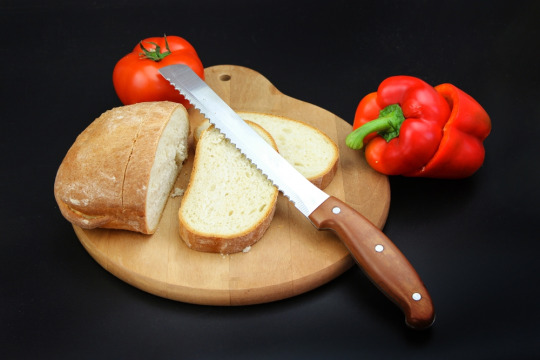
Regular use and care can stable the knife sharper
The best way to keep your serrated knife sharp is to use it regularly. This may seem like common sense, but it is important to remember that knives are like any other tool - the more you use them, the sharper they will stay.
In addition to using your knife regularly, you should also clean and oil it after each use. To clean your knife you can soak the knife after use in warm water or simply wash it with soap. Then air-dry it or clean it with a cloth.
Once your knife is dry, you can apply a few drops of oil to the blade. Any type of cooking oil will do - just make sure it is food-safe. You can use anyone from olive oil or vegetable oil. After applying oil, use a cloth to remove any excess. However, if your knife is already rusted read a complete guide on how to remove rust from knives.
Conclusion | How To Sharpen A Serrated Knife?
With a little practice, you can easily sharpen a serrated knife at home. Just remember to use a honing rod or electric sharpener designed specifically for serrated knives, and to sharpen it more frequently only if necessary. With a sharp serrated knife, you'll be able to tackle any bread or tomato with ease!
Did you find this guide helpful in sharpening your serrated knives? Let us know in the comments below! And be sure to check out our other guides for more tips on how to keep your knives in top shape.
FAQs | Sharp Serrated Knife
When should I sharpen my serrated knife? Serrated knives usually don’t need to be sharpened more frequently unlike traditional knives. If you use it more frequently like daily, sharpen it once every month. Otherwise, they need to be sharpened only once a year.Can I sharpen my serrated knife with a regular knife sharpener?Yes, but it's not good practice to sharpen a knife with a regular knife sharpener. If you use a regular knife sharpener, you'll need to be very careful not to damage the teeth on the blade. It's best to use a honing rod or electric sharpener designed specifically for serrated knives.Is there any forever sharp serrated knife?No, all knives will eventually need to be sharpened. Even if you buy the best quality knives, they’ll become dull and will need to be sharpenedMy knife is still not as sharp as I'd like. What should I do?If your knife is still not as sharp as you'd like, try using a finer grit honing rod or electric sharpener, Or try sharpening it again and more often.
Read the full article
0 notes
Text
Kitchen Shears | How to Clean Kitchen Scissors, Tips For Caring and Benefits

It’s happened to all of us. We are in the middle of cooking a meal and reach for our kitchen shears, only to realize that they are caked with diced onion from the last time we used them. Or, we go to grab them out of the drawer, and they slip through our fingers because they are so greasy. Not only is this frustrating, but it can also be dangerous.
Cleaning your kitchen shears is important for both safety and sanitation reasons. Below is a step-by-step guide on how to clean kitchen scissors, so you can avoid any accidents or cross-contamination in your food.
What are Kitchen Shears?

This dishwasher-safe utensil is perfect for everyday use in the kitchen
Kitchen shears are a type of scissors that are specifically designed for use in the kitchen. They typically have a sleek, ergonomic design that is comfortable to hold and easy to use. Kitchen shears can be used for a variety of tasks, such as cutting meat, vegetables, and herbs.
They can also be used to open packaging or remove rose thorns. In addition, kitchen shears often come equipped with a built-in bottle opener, making them a handy tool to have around the kitchen. Whether you need to open a package of chicken breasts or chop some veggies for dinner, kitchen shears are up to the task.
How to Clean Kitchen Scissors or Shears?
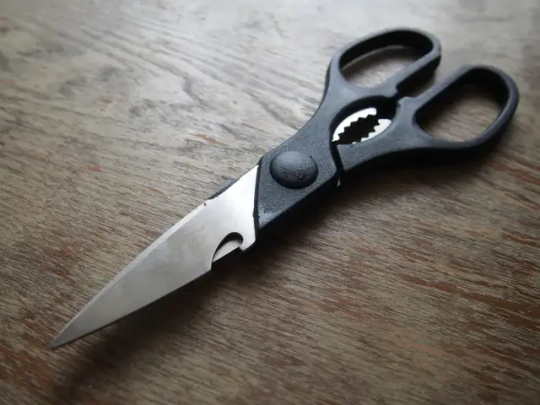
After washing scissors, dry them by hand with a clean towel, paying particular attention to the hard-to-reach areas
Step 1: Unscrew the Blades
The first step is to unscrew the blades of your kitchen shears. Most shears will have a small hole near the joint that you can insert a key or similarly shaped object into and twist. Once the blades are separated, rinse them under hot water to remove any visible debris. You may also want to use a scrub brush to remove any dried-on food particles.
Step 2: Soak the Blades in Vinegar
After you have rinsed the blades, it’s time to soak them in vinegar. This will help to remove any stains or stuck-on particles. Fill a bowl with equal parts vinegar and water and submerge the blades in the mixture. Let them soak for at least 30 minutes, then rinse under hot water. You may need to repeat this step if there are still residual stains on the blades.
Step 3: Wash the Handles
While the blades are soaking, take this opportunity to wash the handles of your kitchen shears. Simply remove any build-up of dirt or grease with a damp cloth and some dish soap. Rinse thoroughly and dry with a clean towel before reattaching the handles to the blades.
Step 4: Dry Thoroughly and Store Properly
Once you have reassembled your shears, make sure to dry them thoroughly before storing them away. Moisture can cause rusting, so they must be completely dry before putting them back in the drawer. It’s also a good idea to store them away from other sharp objects, like knives, to avoid dulling or damaging the blades.
Why Kitchen Shears Must be Cleaned?
Kitchen shears are one of the most versatile tools in the kitchen. They can be used for everything from cutting herbs to snipping chicken bones. However, because they are often used for raw meat, it is important to clean them thoroughly after each use.
Otherwise, they can become a breeding ground for bacteria. The best way to clean kitchen shears is to rinse them in hot water and then disinfect them with a vinegar solution. For a deeper clean, you can also soak them in a mixture of water and baking soda. By taking the time to clean your kitchen shears after each use, you can help keep your kitchen safe and free of harmful bacteria.
Benefits of Kitchen Scissors

Multipurpose utility scissors upgrade your kitchen tools
Kitchen shears are versatile tools that can be used for a variety of tasks, from cutting meat and poultry to snipping herbs and opening packages. But what many people don’t realize is that kitchen shears can also be used to easily remove the stem from a strawberry or slice through a hard-boiled egg. In addition, kitchen shears can be used to cut pizza, make homemade ravioli, or even create decorative garnishes for cakes and cupcakes. With so many uses, it’s no wonder that kitchen shears are an essential tool for any home cook. Moreover,
- They are easy to use
- They are small and easy to store
- They are perfect for precision cutting
- They can cut through a variety of materials
Tips for Caring Kitchen Shears
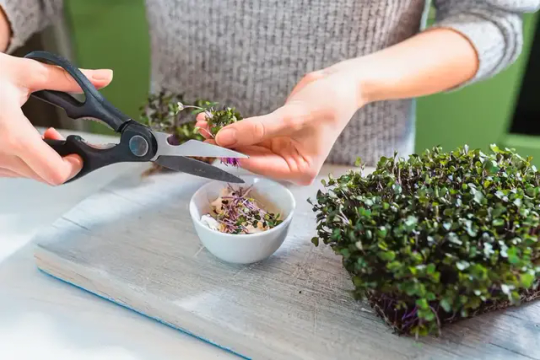
After each use, kitchen shears should be washed and dried
Kitchen scissors are one of the most versatile and hardworking tools in the kitchen. However, like any other tool, they need to be properly cared for to function their best. Here are a few tips for keeping your kitchen scissors in top shape:
- After each use, rinse the scissors with warm water and mild soap. This will help to remove any food particles or grease that may have accumulated on the blades.
- Once a week, disassemble the scissors and clean the blades with a toothbrush. This will help to remove any build-up on the blades and prevent them from becoming dull.
- Once every few months, sharpen the scissors using a honing stone or sharpening steel. This will keep the blades nice and sharp, so they can easily cut through whatever you're working with.
By following these simple tips, you can ensure that your kitchen scissors will always be ready for action.
Conclusion:
Cleaning your kitchen shears might seem like a tedious task, but it’s important for both safety and sanitation reasons. With this step-by-step guide, we hope that now you know easily how to clean kitchen shears and avoid any accidents or cross-contamination in your food preparation.
Read the full article
0 notes
Text
What is a Hidden Tang Knife? How to Make One?

Maybe you're a hunter who likes to prepare his or her own game. Or maybe you're into bushcraft and enjoy the challenge of making your own gear in the great outdoors. In either case, there's a good chance you'll want to know about what is a hidden tang knife.
A hidden tang knife is a type of knife where the blade is inserted into the handle through a hole at the end of the handle. This makes the blade stronger because it's sandwiched between two pieces of metal. It also makes the knife less likely to loosen over time.
But that's not all. A hidden tang knife is also easier to clean than a traditional full-tang knife. All you have to do is remove the blade from the handle and wash everything separately.
In this article, we'll show you how to make a handle for a hidden tang knife. We'll also explain what tang means on a knife and how it affects the knife's performance. We'll end with some tips on choosing the right materials to make your hidden tang knife handle.
So if you want to learn more about this type, or are looking to create your own knife, then read on.
What is a Hidden Tang Knife?

Outdoor Knife Full Tang Camping Knife-Belt Knife
A hidden tang knife is a type of knife in which the tang is not visible. The tang refers to the portion of the blade that extends into it. In most knives, the tang is visible, but in a hidden tang knife, it is hidden within the handle. This gives your knife a more sleek appearance and makes it easier to hold. Hidden tang knives are often used for hunting and outdoor activities. Due to their unique design, they are very popular with collectors.
Benefits of Using a Hidden Tang
- Increased Durability - The hidden tang knife is more durable than a full-tang knife, due to its sturdier construction.
- Strength and Stability - The hidden tang provides extra strength and stability, making it ideal for heavy-duty use.
Drawbacks of Using a Hidden Tang
- Rarely available on the market - You won't find many hidden tang knives on the market, which makes them quite collectible.
What Does Tang Mean On a Knife?

This knife supports your outdoor activities in many ways. Whether it comes to building accommodation, collecting firewood, or sourcing food
The tang is the portion of the knife's blade that extends into its handle. A full tang runs the entire length of the handle, while a partial tang extends only a part of the length. A knife with a full tang is generally stronger and more durable than one with a partial tang, as the steel is better supported. However, knives with partial tangs can be lighter and more maneuverable, making them a good choice for certain types of tasks.
How Does the Knife Tang Affect your Knife?
The tang is the metal portion of a knife that extends into its handle. The type of tang can have a significant impact on a knife's performance. A full tang provides the most strength and durability, while a Rat-tail tang is more fragile.
A hidden tang is somewhere in between, offering more strength than a Rat-tail but not as much as a full tang. When choosing a knife, it is important to consider what type of tasks it will be used for. If the knife will see heavy use, then a full or hidden tang is a better option. If it will be used primarily for light tasks, then a Rat-tail may suffice. Ultimately, the type of tang should be matched to the intended use of the knife.
Making Hidden Tang Knife Handle
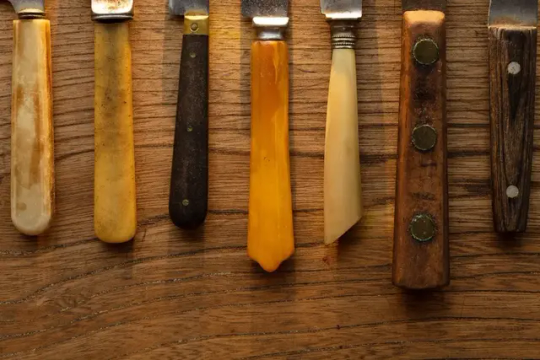
Non-slip handle, comfortable to touch, and is ergonomic
So, now we'll be making the handle for a hidden tang knife. This type of knife has the blade mounted inside the handle, with the tang (the part of the blade that goes into the handle) hidden from view. This makes for a strong and durable knife, as there is no weak point where the blade meets the handle.
The first step is to choose your materials. For the handle, you will need a piece of wood at least 6" long and 1" wide. You will also need some epoxy glue, a drill, a drill bit slightly smaller in diameter than the tang of your knife, and a saw.
The next step is to cut your piece of wood to size. If you are using a pre-made knife blank, you can simply measure out 6" from one end and make a mark. If you are using a piece of scrap wood, you will first need to measure and mark out a 6"x1" piece.
After you've cut your piece of wood to the right size, you can drill the hole for your tang. Begin by drilling a pilot hole in the center of your wood. Then, use the drill bit to drill out the hole for the tang. It's important that the hole is slightly smaller in diameter than the tang of your knife, as this will create a snug fit and help keep the blade in place.
Next, it's time to glue the handle together. Apply a layer of epoxy glue to one end of the wood, then insert the tang of the knife into the hole. Clamp or weight down the other end of the wood so that it applies pressure to the glued end. Let dry overnight.
Finally, use a saw to cut off any excess wood from either end of the handle. Your hidden tang knife is now ready for use!
When choosing a material for your hidden tang knife handle, it's important to consider the weight, balance, and durability of the material. Wood is a popular choice for hidden tang knife handles, as it is lightweight and easy to work with. However, Wood can be more difficult than other materials to clean. Metal and plastic are also good choices for hidden tang knife handle materials.
Tips for Installing Your New Hidden Tang Knife Handle
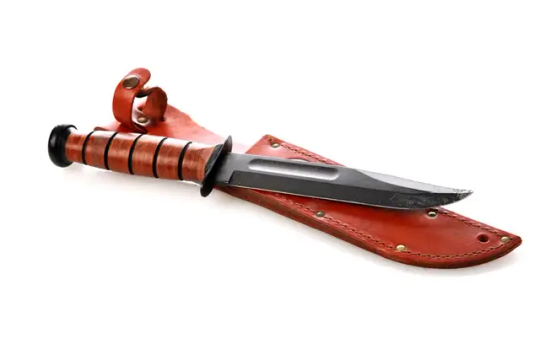
A luxurious, durable oak handle ensures maximum comfort and safety for users of all sizes
If you are new to making hidden tang knife handles, here are a few tips to help you get started:
- When installing your new hidden tang knife handle, make sure that the blade is secure in the handle. You don't want it to come loose while you're using it.
- Check the screws on a regular basis to make sure that they are tight. You don't want the blade coming loose while you're using it.
- Allow the epoxy to dry completely before using your knife.
Final thoughts
A hidden tang knife is a great option for those looking for a strong and durable knife. While they are not as light or agile as Full tang knives, they offer more strength and stability. When choosing a hidden tang knife, be sure to consider the intended use and choose a handle material that is appropriate. With proper care, your hidden tang knife will provide you with years of service.
Buy a hidden tang knife now and experience the difference for yourself!
Read the full article
0 notes
Text
Kiritsuke knife vs Chef Knife - A detailed article
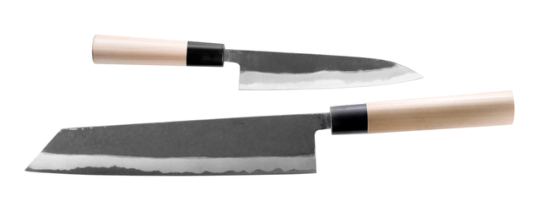
There are many different types of knives available on the market. There are standard kitchen knives and more specialized knives such as a Kiritsuki knife or a Chef Knife.
These two knives have very specific purposes and while they may seem to do similar tasks, there are still some important differences between each type. Let's break down
the Kiritsuke knife vs chef knife for what you might use these knives for and the benefits of using each one in different situations.
Quick Overview of Differences
FeatureKiritsuke KnifeChef KnifeBlade LengthLonger (8-10 inches)Shorter (6-8 inches)Blade CurveMore Gradual CurveMore Pronounced CurveWeight Light WeightHeavierBalanceBetter BalancedLess BalanceDurabilityLess DurableMore DurableManeuverabilityLess DurableDifficult to ManeuverMaintenanceDifficult To Maintain/SharpenEasier Maintenance
What is a Kiritsuke Knife?
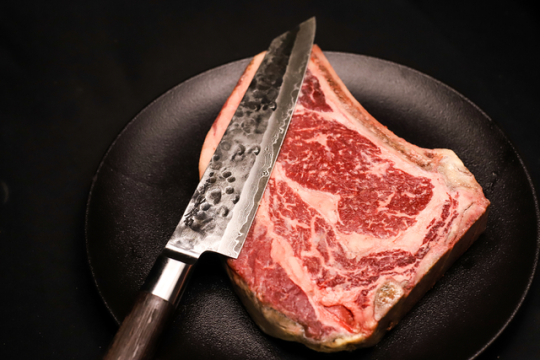
Kiritsuke Chef's Knife, Ideal for All-Around Food Preparation
Kiritsuke knives are a Japanese type of knife that can be used to cut and chop vegetables and make fish dishes. The blade is characteristically long about 8-10 inches and straight, with a curved tip generally higher curvature than a santoku knife. Some kiritsuke knives also have a Granton edge, a series of small grooves that help prevent food from sticking to the blade.
While kiritsuke knives are often used as all-purpose kitchen knives, they are particularly well-suited for tasks that require precise cuts, such as julienning carrots or slicing fish fillets. In addition, the elongated blade of a kiritsuke knife makes it ideal for use as a Sweeney Todd razor. As such, these versatile knives are an essential tool in any well-equipped kitchen.
History
The Kiritsuke knife is a Japanese blade with a long and storied history. Initially developed in the 17th century by the samurai Yasutsuga Nakamura, the Kiritsuke has undergone many changes over the years. Today, it remains a popular choice for chefs and home cooks alike, thanks to its versatile design.
The Kiritsuke is often used as an all-purpose knife, capable of performing many different tasks in the kitchen. Whether you're slicing vegetables, filleting fish, or removing fish skin, this knife can handle it all. With its sharp blade and sleek profile, the Kiritsuke is a beautiful addition to any kitchen.
What is a Chef's Knife?
A chef knife is a multi-purpose knife and can be used to slice, chop, or mince The gyuto/chef knife has a 6-8 inches long, curved blade that is ideal for slicing through meats and vegetables. The blade is also thin and sharp, making it easy to create precise cuts.
A Chef Knife is typically used as the primary all-purpose knife in a Japanese kitchen. In addition to being an essential tool for preparing daily meals, it is also commonly used for sushi preparation. It can be used to slice fish and seafood, as well as to roll and cut sushi rolls. A chef knife is an essential tool for any chef who wants to create authentic Japanese cuisine.
History
A chef knife is a kitchen staple for anyone who loves to cook. But where did this versatile tool come from? The modern chef knife was developed in France in the 19th century. At that time, French chefs were looking for a knife that could be used for both chopping and slicing, and the chef knife fits the bill perfectly.
Soon, the chef knife became a standard piece of equipment in professional kitchens across Europe. In the 20th century, the chef knife began to gain popularity among home cooks as well. Today, it's a vital tool for any cook who loves to spend time in the kitchen. It doesn't matter if your goal is to be a professional chef, or just to spend time in the kitchen, a high-quality chef knife can prove valuable.
Chef Knife vs Kiritsuke - Key Differences
The main difference between Kiritsuki knife and a chef knife is the blade length and shape blade curve. Every kitchen needs at least one good chef’s knife. But what if you’re a sushi chef, or you regularly prepare traditional Japanese cuisine? In that case, you might want to consider adding a Kiritsuki knife to your collection. Here’s a quick overview of the key differences between these two types of knives:
Blade Length and Shape
The Kiritsuki knife has a longer, thinner blade than the typical chef’s knife. It’s also slightly curved, which makes it ideal for slicing and chopping fish. The Chef knife is smaller and thicker, and it has a more rectangular form. This makes it ideal for chopping vegetables or other dense foods.
Blade Curve
The curve of a knife blade affects its slicing and chopping efficiency. A kiritsuke knife has a more gradual curve than a chef knife, making it better suited for slicing fish. Conversely, a chef's knife has a more pronounced curve, making it better at chopping vegetables.
Weight and Balance
The Kiritsuki knife is generally lighter and better balanced than a chef’s knife, making it easier to control during delicate cutting tasks.
Durability and Resistance
The kiritsuke knife is not as durable as a chef knife. It is not meant to be used for intense chopping and slicing but is better suited for more delicate tasks. Chef knives, on the contrary, can withstand greater force and be used for many tasks in the kitchen.
Maneuverability
While Chef knives are larger and heavier, they are not as maneuverable as kiritsuke knives. This is because they have longer blades and are bulkier. This makes them more difficult to control and requires more strength to use. Kiritsuke knives are smaller and lighter, making them easier to handle. They are also more versatile, as they can be used for slicing, dicing, and chopping.
Cleaning and Maintenance
Kiritsuke knives are made from harder steel than chef knives. They also have a more complex blade geometry, which means they are more difficult to sharpen. Chef knives are made from softer steel, which makes them easier to sharpen, but also means they are more prone to chipping.
Because of the harder steel and more complex blade geometry, kiritsuke knives require more care and maintenance than chef knives.
So, which type of knife is right for you? If you’re primarily a sushi chef or you frequently prepare traditional Japanese cuisine, then the Kiritsuki knife is probably the better choice. However, if you don’t have specific needs like those, then a standard chef’s knife will probably suffice.
How to choose your knife?

Kiritsuke Professional Chef Knife
It really depends on what you will be using your knife for. If you are looking for a Kiritsuke knife, then you should consider the key differences between the two types of knives. If you need a knife that is better suited for slicing and chopping fish, then go for a Kiritsuke knife. However, if you need a knife that is more versatile and can be used for a variety of tasks, then a chef knife might be the better option.
Pros and Cons of Kiritsuki knife
A Kiritsuki knife is a type of Japanese kitchen knife that is typically used for slicing and dicing fish. It has a single-edged blade that is slightly curved and has a pointed tip. The blade of a Kiritsuki knife is usually about 8-10 inches long.
One of the main advantages of using a Kiritsuki knife is that it is very sharp. This makes it ideal for cutting through tough fish skin. Additionally, the curved blade of the Kiritsuki knife helps to create even slices of fish flesh.
Another advantage of the Kiritsuki knife is that it is relatively lightweight. This makes it easy to handle and maneuver, even for those who are not used to handling larger kitchen knives.
However, there are also some disadvantages to using a Kiritsuki knife. One of the main drawbacks is that the blade can be fragile and may chip or break if it hits a hard surface. Additionally, the pointed tip of the blade can make it difficult to control when slicing through thick pieces of fish flesh.
Pros and Cons of Chef Knife
A chef knife is a type of kitchen knife that is typically used for chopping and slicing vegetables. It has a curved blade that is about 6-8 inches long.
Chef knives are popular because they are versatile and can be used for a variety of tasks in the kitchen, such as slicing, dicing, and chopping. They are also relatively affordable when compared to other types of kitchen knives.
However, there are also some disadvantages to using a chef's knife. One of the main drawbacks is that chef knives can be bulky and difficult to maneuver. This makes them less suitable for more delicate tasks, such as slicing fish.
What are Western Knives?
As you may know, there are two main types of knives in the culinary world - Western knives and Japanese knives. Let’s see western knives also known as western chef knives in detail.
Western knives are typically made from one piece of stainless steel, which offers a good balance between durability and ease of care. The blade is usually about 8 inches long, although you can find shorter and longer versions. The handle is often made from wood or plastic, and the bolster (the part of the knife where the blade meets the handle) provides added stability and weight.
When it comes to cutting, Western knives are designed for a variety of chopping, slicing, and dicing techniques. The blade is usually fairly wide, which gives you more surface area to work with when chopping. And the slightly curved edge helps you rock the knife back and forth to create thinner slices.
One of the benefits of using a Western knife is that they're widely available and relatively affordable. You can find them at most kitchen stores or online retailers. And because they're so popular, there's a lot of variety in terms of style and quality.
Conclusion - Kiritsuke Knife vs Chef Knife
After reading this chef knife vs kiritsuke comparison, you should have a better understanding of the key differences between these two types of knives. If you need a sharp knife for slicing and dicing fish, then go for a Kiritsuke knife. However, if you need a versatile and affordable knife for general kitchen tasks, then a chef knife would be a better option.
Kiritsuke knife vs Gyuto
Kiritsuke knife Pros: -Very sharp -Lightweight and easy to handle
Kiritsuke knife Cons: -The blade can be fragile and may chip or break -Difficult to control when slicing through thick pieces of fish flesh
Chef knife Pros: -Relatively affordable -Versatile and can be used for a variety of tasks
Chef knife Cons: -Can be bulky and difficult to maneuver -Less suitable for more delicate tasks
So, which knife is better for you? It really depends on your needs and preferences.
I hope you found this Kiritsuke knife vs chef knife comparison useful. If you have any questions or comments, please feel free to leave them below. Thanks for reading!
FAQs
What is a Kiritsuke knife used for? Kiritsuke knives are typically used for slicing and dicing fish. However, they can also be used for other kitchen tasks such as chopping and slicing vegetables.What is a chef's knife used for?Chef knives are versatile and can be used for a variety of tasks in the kitchen, such as slicing, dicing, and chopping.Which knife is sharper - Kiritsuke or chef?Kiritsuke knives are usually sharper than chef knives. However, this difference is not always significant, and it really depends on the quality of the knife.Which knife is better for slicing fish - Kiritsuke or chef?Kiritsuke knives are better for slicing fish because they are lighter and easier to control. Chef knives can be more difficult to maneuver and may not provide as clean of a slice.How do you pronounce Kiritsuke?Kiritsuke is pronounced as "keer-ee-tsoo-kay".
Read the full article
0 notes
Text
The Basics Of Damascus Pocket Knives? Why So Popular?

Damascus Pocket Knives: Pocket knives are one of the most versatile tools a person can own. They come in all shapes and sizes, with an endless variety of blades and functions. But what exactly is a Damascus pocket knife? And why are they so popular? In this article, we'll explore the basics of Damascus pocket knives, including what they are, how they are made, and the benefits of owning one.
What Are Damascus Pocket Knives?
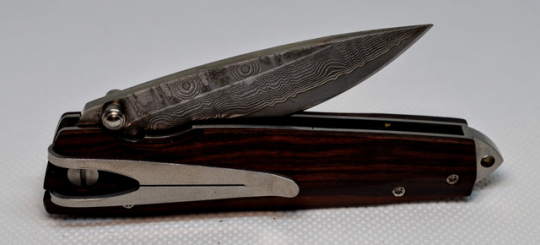
Pocket Knife for Men
A pocket knife is a small, folding knife that can be carried in a pocket. Pocket knives have been around for centuries and were originally designed for utility purposes such as whittling, carving, and cleaning games.
Today, Damascus pocket knives are still used for these purposes, but they are also popular collectibles and gifts. Damascus Pocket knives come in a wide variety of sizes, shapes, and styles, and they can be made from various materials including wood, bone, stainless steel, and carbon fiber. Some pocket knives even incorporate features such as bottle openers and corkscrews.
What are Damascus pocket knives and why are they so popular?
Damascus steel pocket knives are made from Damascus steel, which is a type of steel that is known for its strength and durability. Damascus steel is created by forge-welding multiple layers of steel together and then folding and pounding the metal to create a distinctive pattern.
These pocket knives are popular because they are not only strong and durable but also beautiful. The Damascus steel used to make these knives has a unique mottled appearance that is created by the forge-welding process. They are also often handmade, which adds to their appeal.
What is Damascus Steel?

Damascus Steel Bar - Custom Damascus Steel Billet
Damascus steel knives are very durable and strong. These knives were developed thousands of years ago in Egypt and Syria. They were made from steel that was produced from pure iron ore. The technique of producing them is called the "hammered and folded" process. You will find it in many ancient cultures. Today, you can still buy Damascus steel knives in some shops and online. Many people love these knives because they are so durable and strong.
How are Damascus Pocket Knives made?
Damascus pocket knives are made using a process called forge welding. This process involves combining multiple layers of steel together and then folding and pounding the metal to create a distinctive pattern. Damascus steel is known for its strength and durability, making it an ideal material for pocket knives.
The Damascus steel used to make these knives is often handmade, which adds to their appeal. These pocket knives are also usually handmade, which means that each one is unique.
The Benefits of Owning a Pocket Knife
A pocket knife is an essential tool for anyone who enjoys spending time outdoors. Whether you are hiking, camping, or simply working in the garden, a good pocket knife can be used for a variety of tasks. From cutting rope and cord to preparing food, a pocket knife is a versatile and convenient tool to have on hand.
In addition to being useful, pocket knives can also be collectible and make great gifts. With so many different styles and designs available, there is sure to be a pocket knife that suits your needs and taste. Whether you are looking for a functional blade or a beautiful piece of art, owning a pocket knife is sure to bring you enjoyment.
The care and maintenance of a Damascus Steel pocket knife

Rust Erasers Cleaning Kitchen Knife
While Damascus steel knives are notoriously difficult to care for, a few simple steps can help to keep your knife in pristine condition.
- First, always clean the blade after using it, using only mild soap and water.
- Never put your knife in the dishwasher or submerge it in water for extended periods of time.
- Sharpen the blade regularly using a honing rod or sharpening stone.
- Apply a thin layer of mineral oil to the blade after each use to help protect it from rust.
With a little bit of care, your Damascus steel pocket knife will provide you with a lifetime of pleasure.
Different Types of Damascus Steel Pocket Knives
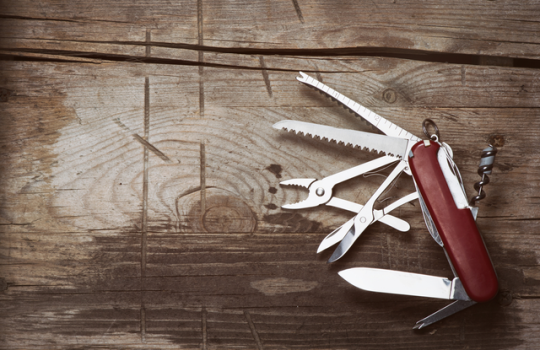
Ultimate value in multi-use of pocket knife for everyday
Damascus steel is a type of steel known for its distinctive patterns. This makes these knives a popular choice for collectors and enthusiasts.
There are several different types of Damascus pocket knives, including single-blade, multi-blade, and Swiss knives. Each type has its own unique benefits and features, making them ideal for different tasks.
Single-blade pocket knives are perfect for everyday tasks, while multi-blade pocket knives offer a variety of blades that are ideal for more demanding tasks.
The Swiss army knife is a type of multi-blade pocket knife that offer a variety of tools in addition to blades, such as scissors, screwdrivers, and bottle openers.
Is it Legal to Hold Damascus Steel Pocket Knives in the USA?
Yes, Damascus steel pocket knives are legal to own in the United States. However, there are a few restrictions that you should be aware of.
If you are interested in purchasing a Damascus steel pocket knife, check with your local laws and regulations first.
Conclusion
Pocket knives are often just seen as tools, but they can be so much more than that. Damascus pocket knives are some of the most popular on the market and for good reason. These hand-forged Damascus pocket knives are made with incredible craftsmanship, resulting in a beautiful and functional knife.
There are many different types of Damascus blades, each with its own unique benefits. Owning a pocket knife offers a variety of advantages, from being able to perform basic tasks to providing self-defense. It is important to know how to care for your pocket knife so that it lasts a lifetime.
We hope you enjoyed this article on everything about a Damascus pocket knife. If you have any questions or would like to learn more about pocket knives, please feel free to contact us. Thanks for reading!
Read the full article
0 notes
Text
Why Are Sushi Knives one Sided? Reasons and Benefits
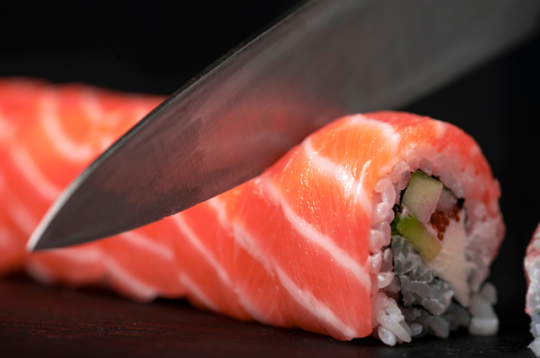
Sushi knives are one-sided because they are designed for a specific purpose – cutting sushi. The single bevel creates a sharp edge that is perfect for slicing through delicate fish and rice.
Sided? Reasons and Benefits
In this article, we'll answer the question: "why are sushi knives one sided? '' in detail. We'll also discuss the benefits of having a single bevel blade and answer some common questions about one-sided sharpness of sushi knives.
What is a Sushi Knife?
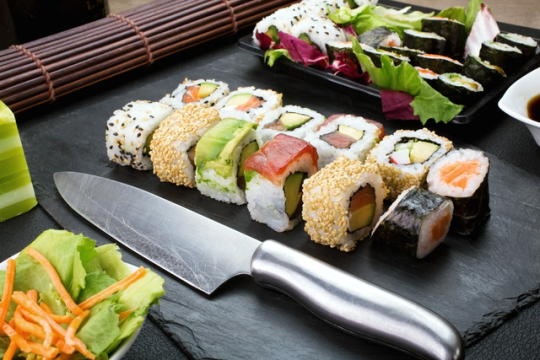
Perfect cuts of sushi or sashimi with the sharp knife
A sushi knife is a type of knife that is specifically designed for cutting sushi. The blades of these knives are usually single-beveled, meaning that they have a sharp edge on one side and a duller edge on the other. This design helps to create clean, precise cuts when slicing through fish and rice.
Why are Sushi Knives one Sided?

sushi one sided chef knife
There are a few reasons why sushi knives are typically one-sided.
- First, the single-bevel design creates a sharper edge. This is because the blade is only ground on one side. This is crucial when you want to make precise, clean cuts.
- The one-sided design helps to prevent the sushi from sticking to the knife. When you are cutting sushi, you want the fish and rice to stay intact and not stick to the blade. Moreover, It is easier to sharpen only one side of the knife.
- Sushi knives are one sided because they are meant to be used with one hand. This is due to the fact that sushi is typically eaten with chopsticks, and using a two-handed grip would be difficult. Having a one-sided blade also allows for more precision cuts, which is important when making sushi.
- Finally, one sided knives simply work better for slicing sushi. The thin, sharp blade can easily glide through fish without crushing it or tearing it apart. This results in perfect, delicate slices of sushi every time.
Pros and Cons of Single Bevel Knife

Single bevel Sharp Knives for Kitchen
When it comes to sushi knives, there is a great debate over which type of knife is better - a single bevel or a double bevel. A single-bevel knife is only sharpened on one side, while a double-bevel knife is sharpened on both sides. So, what are the pros and cons of a single-level knife? Let's take a closer look.
Single Bevel Pros:
- Greater precision - When you're slicing sushi, precision is key. A single bevel knife allows you to make very thin, precise slices.
- Easier to sharpen - Since only one side of the blade is sharpened, it's much easier to get a good edge on a single bevel knife.
- Unique look - Let's face it, sushi knives with a single bevel just look cool. They have a traditional look that screams "sushi chef."
Single Bevel Cons:
- Requires more skill to use - A single-bevel knife requires a bit more skill to use than a double bevel knife. If you're not used to using this type of knife, you may find yourself struggling to slice sushi evenly.
What is the best Sushi Knife in 2022?

The right one and best sushi knife
There are many options for sushi knives. How do you choose the right one? These are some things to remember when looking for the best sushi knives.
Blades – Sushi knives are available in many sizes and shapes. Choose the right size blade for your needs.
Type of Knife - There are three types of sushi knives to choose from Deba, Yanagi-ba, and Usuba. Each knife has a specific purpose
Sharpness - This is the most important factor to consider when selecting a sushi knife. Make sure to choose a knife that is sharp enough to cut through fish and rice easily.
Handle - Your sushi knife's handle should be easy to grasp. Choose a handle that fits your hand. Sushi knives that are tailored to your needs and preferences are the best.
The best sushi knives are those that fit your individual needs and preferences. So, be sure to take into account the different factors listed above before making your purchase. Read a list of best sushi knives in 2022 in which we've compiled a list of best knives for sushi in 2022 by taking all the above-mentioned factors into consideration.
What is a Single Edged Knife Called?
A knife with a single sharpened edge is called a Kataba or chisel. This type of knife is common in Japanese cuisine, where it is used for tasks such as chopping vegetables, slicing fish, and making sushi.
Do all Sushi Knives have to be one Sided?
No, not all sushi knives have to be one-sided. Some sushi chefs prefer to use double-edged knives because they feel that it gives them more control over the blade. However, most sushi knives are one-sided because of the benefits that we discussed earlier.
Conclusion | Why are Sushi Knives one Sided?

kitchen knife important tool used in cooking
If you're a sushi lover, then you know that sushi knives are one of the most important tools in the kitchen. But have you ever wondered why is a sushi knife edge single? It turns out that there's a very good reason for it. The one-sided design of the sushi knife allows for a cleaner cut, which in turn results in a more attractive and appetizing sushi roll. So next time you're at your favorite sushi spot, take a closer look at the knives they're using — you'll be impressed by how much difference the right tool can make.
Do Japanese knives only have one side sharpened?While most Japanese knives are sharpened on one side, there are a few exceptions. Some sushi chefs prefer to use double-edged knives because they feel that it gives them more control over the bladeWhat's the difference between a single and double bevel?A single bevel knife has only one side that is sharpened, while a double bevel knife has two sides that are sharpened. The one-sided design of the sushi knife allows for a cleaner cut, which in turn results in a more attractive and appetizing sushi roll.What does single bevel mean?A single bevel knife has only one side that is sharpened. The other side is either flat or grounds very thick. This leaves a much sharper edge on one side of the blade.How do you sharpen a single bevel knife?To sharpen a single bevel knife, you will need to use a honing rod or sharpening stone. First, find the angle you need to sharpen the blade at. For most sushi knives, this will be around 20 degrees. Next, use a honing rod or sharpening stone to hold the blade at that angle and sharpen the edge. Remember to only sharpen one side of the blade!What is a back bevel on a knife?A back bevel is a bevel that starts at the spine of the knife and goes towards the edge. Back bevels are used to thin out the blade and make it sharper.
Read the full article
0 notes
Text
What is A Pairing Knife Used For?

A lot of people might not know what a pairing knife is used for. A pairing knife is most commonly used in the kitchen as a slicing tool. It can be used to cut small or delicate items, such as herbs, without crushing them. A pairing knife is a small, sharp knife that is used for a variety of tasks in the kitchen, including peeling and slicing fruits and vegetables. While it is called a "pairing" knife, it can actually be used for much more than just pairing fruits and vegetables! In this blog post, we’ll explore some of the many different uses of a pairing knife.
What is A Pairing Knife?
A pairing knife is a small, thin blade that is used for delicate tasks such as slicing small fruits and vegetables. It is also called a paring knife. The blade is typically between 2 and 4 inches long, and the handle is designed for a comfortable grip.
Paring knives are often used in professional kitchens to peel and slice fruits and vegetables. They can also be used to cut small meat cuts or to devein shrimp. The thin blade allows the user to make precise cuts, and the small size makes it easy to control the knife.
Most paring knives are made of stainless steel, which makes them durable and easy to clean. They can be used for both light and heavy-duty tasks, making them versatile tools in the kitchen.
The Many Uses of a Pairing Knife
1. Slicing Fruits and Vegetables
One of the most common uses for a pairing knife is slicing fruits and vegetables. The sharp blade and small size of the knife make it perfect for peeling and slicing fruits and vegetables quickly and easily.
2. Cutting Bread
A pairing knife can also be used to cut bread into thin slices. This is especially useful if you are making sandwiches or toast with thick slices of bread.
3. Spreads and Jams
Another common use for a pairing knife is spreading spreads and jams on bread or crackers. The sharp blade of the knife helps to evenly spread the spread or jam without tearing the bread or cracker.
4. Garnishes
Pairing knives are also great for adding garnishes to your dishes. Garnishes can include things like thinly sliced lemons or limes, chopped herbs, or grated cheese. Adding a garnish to your dish can help to elevate it from ordinary to extraordinary!
5. For Scoring
Scoring is a technique that is often used in cooking and baking. It involves making shallow cuts on the surface of the food. This can be done for a variety of reasons, such as to prevent shrinking during cooking or to allow heat to penetrate the food more evenly. A pairing knife is a perfect tool for scoring because of its sharp blade and small size.
6. Segmenting
Segmenting citrus fruits is a technique that is used to remove the fruit from the membrane. This is often done when making juices or cocktails. A pairing knife is also used for segmenting citrus fruits because of its sharp blade and small size.
7. Deveining
If you are looking for a quick and easy way to devein shrimp, a pairing knife is a perfect tool. The sharp blade of the knife can easily remove the vein from the shrimp, leaving you with a delicious and healthy seafood dish.
The Different Types of Paring Knives
Curved Tip Paring Knife
The curved tip paring knife has a blade that is curved at the end, making it ideal for peeling round fruits and vegetables such as apples and potatoes. The curved blade allows you to follow the contour of the fruit or vegetable as you peel, resulting in less waste and a more aesthetically pleasing peel.
Bird’s Beak Paring Knife
The bird’s beak paring knife gets its name from its blade shape, which resembles the beak of a bird. This type of paring knife is designed for precision work such as removing blemishes from fruits and vegetables, deveining shrimp, or hulling strawberries. The sharp point of the blade also makes it ideal for piercing holes into fruits and vegetables.
Serrated Blade Paring Knife
The serrated blade paring knife has a jagged edge that is perfect for slicing soft fruits and vegetables such as tomatoes and oranges. The serrations on the blade help to grip the surface of the fruit or vegetable, making it easier to slice through without crushing or squishing delicate ingredients.
Sheepsfoot Paring Knife
The sheepsfoot paring knife gets its name from its distinctive blade shape which resembles the hoof of a sheep. This type of knife is designed for slicing fruits and vegetables into uniform pieces, making it ideal for dicing or chopping ingredients. The straight edge of the blade also makes it useful for trimming fat or sinew from meat.
There are many different types of paring knives available on the market, each with its own unique blade shape that is designed for a specific purpose. In this blog post, we have discussed four of the most common types of paring knives: the curved tip paring knife, the bird’s beak paring knife, the serrated blade paring knife, and the sheepsfoot paring knife.
Caring for Paring Knife
Like all knives, a pairing knife also requires proper care and maintenance in order to function properly and last long. Here are a few tips on how to take care of your paring knife.
Use a cutting board
Always use a cutting board when using your paring knife. A cutting board will protect your countertop from getting scratched as well as dulling your knife.
Avoid the dishwasher
The dishwasher is one of the worst enemies of knives. The harsh chemicals and high temperatures can damage the blade and handle of your paring knife. Instead, wash it by hand with warm soapy water and dry it immediately after.
Sharpen regularly
A dull knife is more dangerous than a sharp one. It is also more likely to cause accidents such as cuts. Therefore, it is important to sharpen your paring knife on a regular basis. You can use a honing rod or a sharpening stone to do this.
Conclusion
A pairing knife is a multipurpose kitchen tool that can be used for everything from slicing meat to cutting vegetables. Its versatility means that it is perfect for anyone, regardless of their experience or cooking skills. Plus, its small size makes it easy to store and transport, so you can always have it on hand when you need it.
There are many different uses for a pairing knife in the kitchen. Whether you are slicing fruits and vegetables, cutting bread, spreading spreads and jams, or adding garnishes, a pairing knife is a versatile tool that every home cook should have in their kitchen arsenal!
Read the full article
0 notes